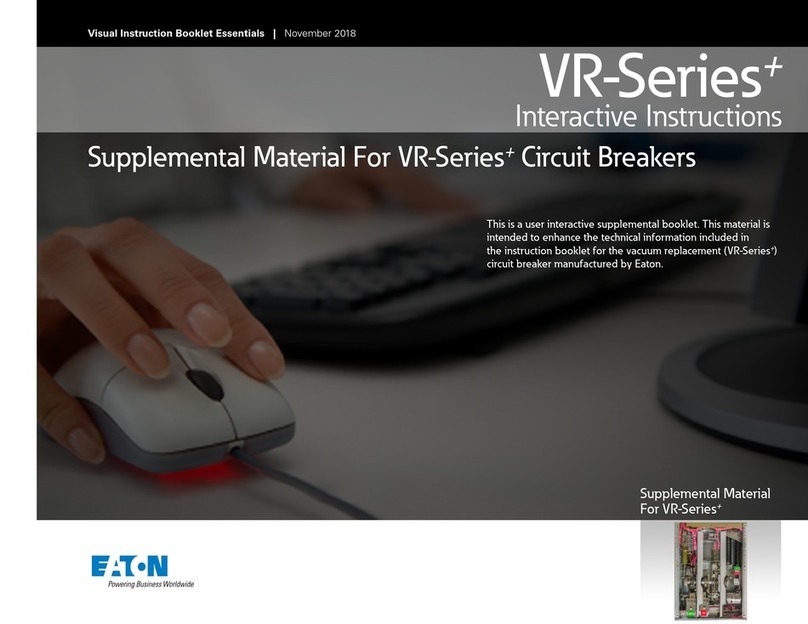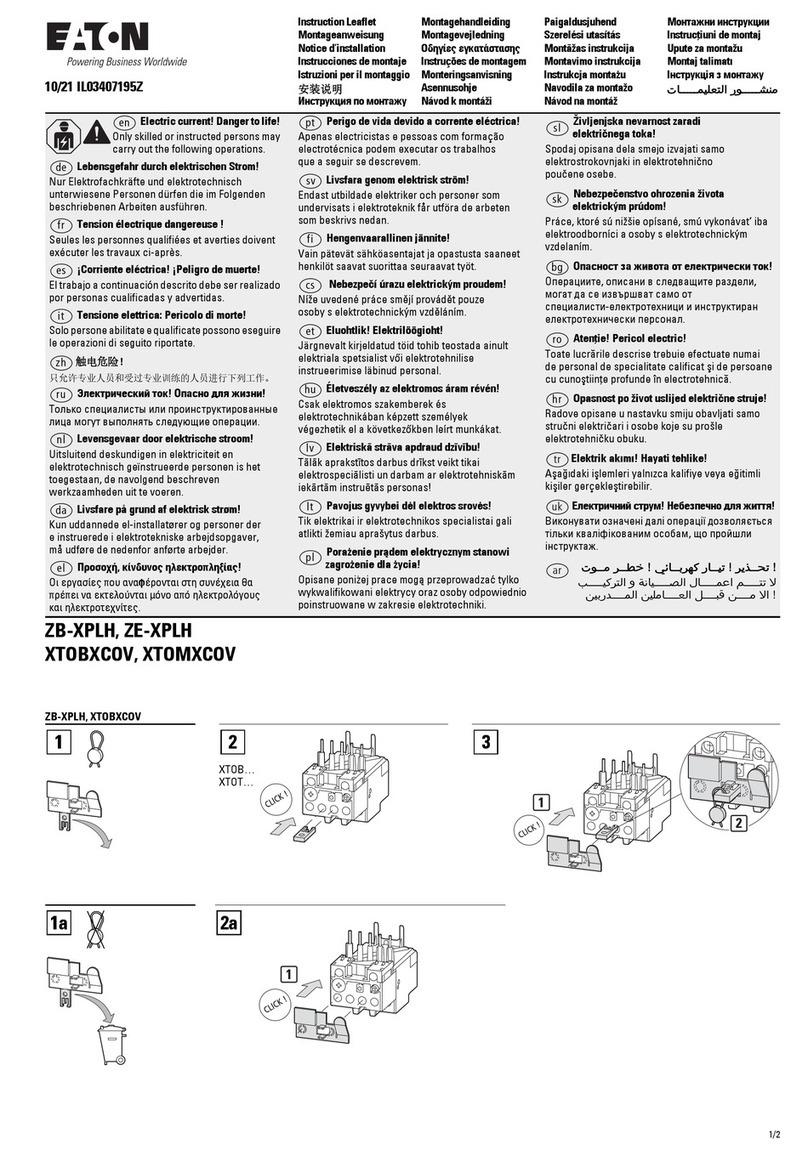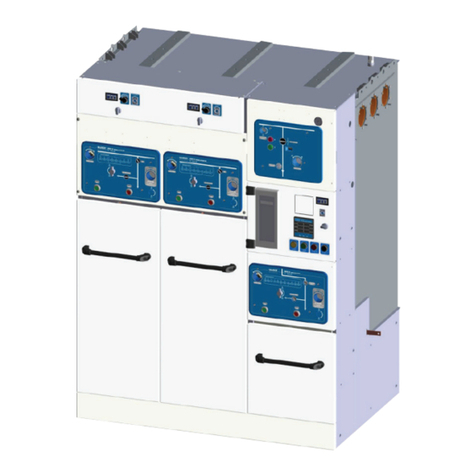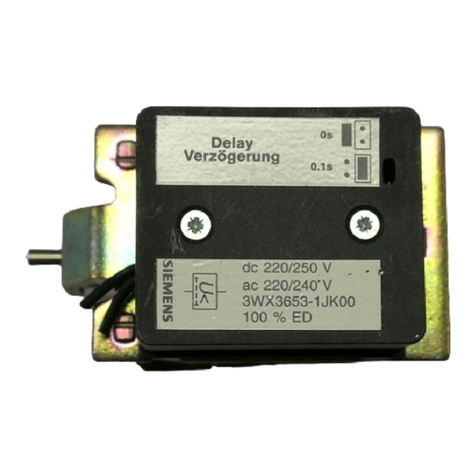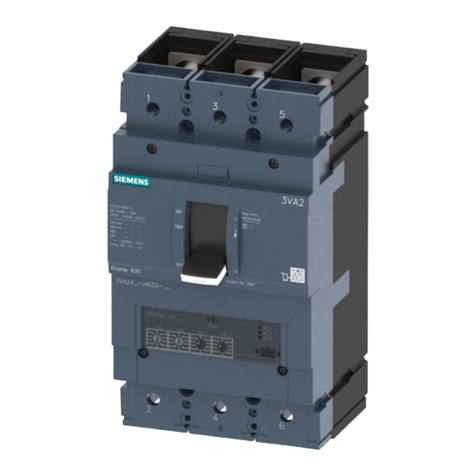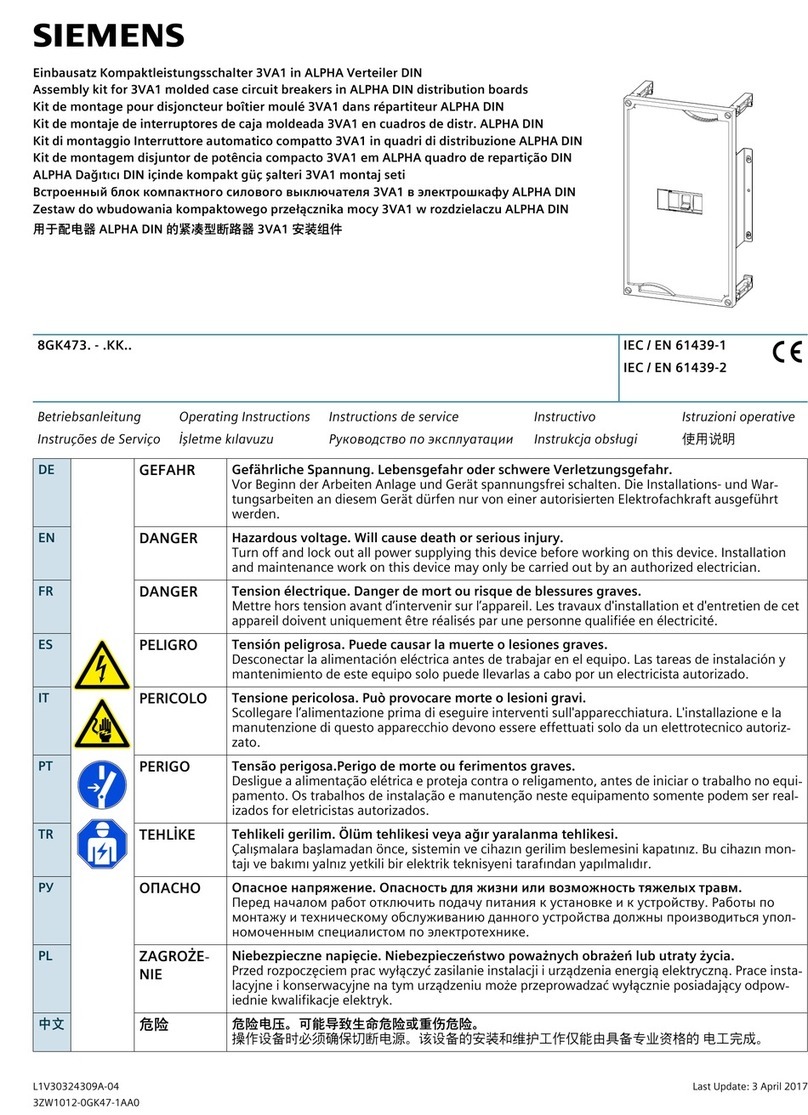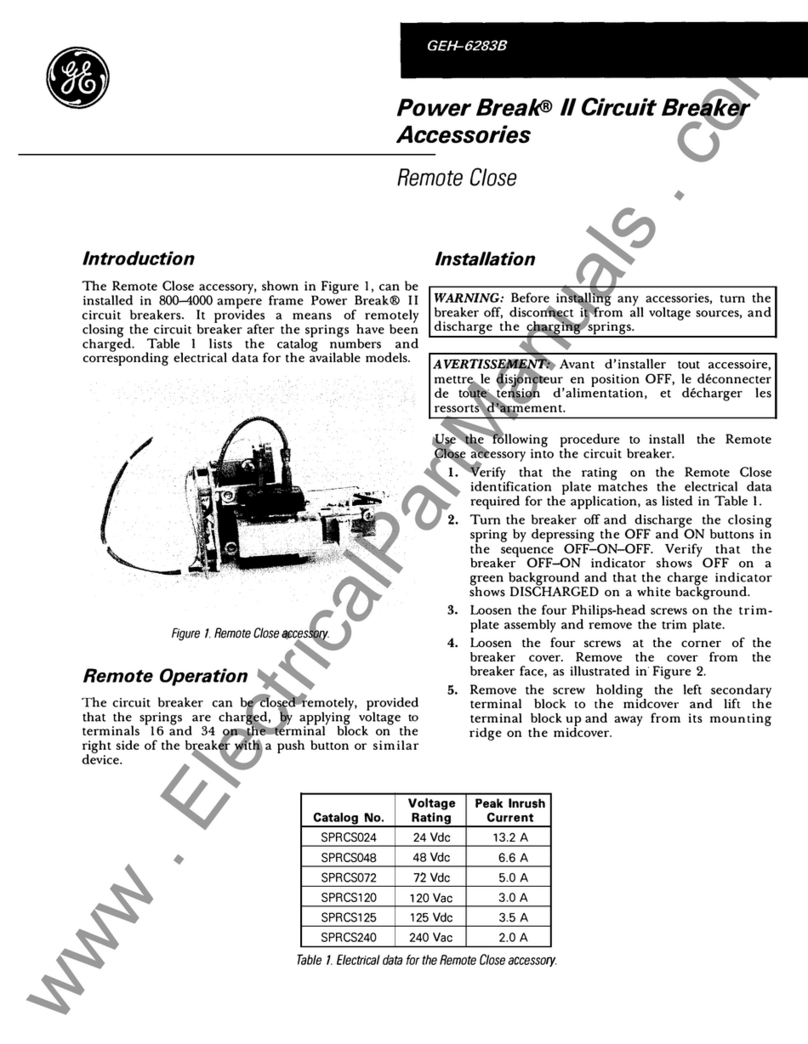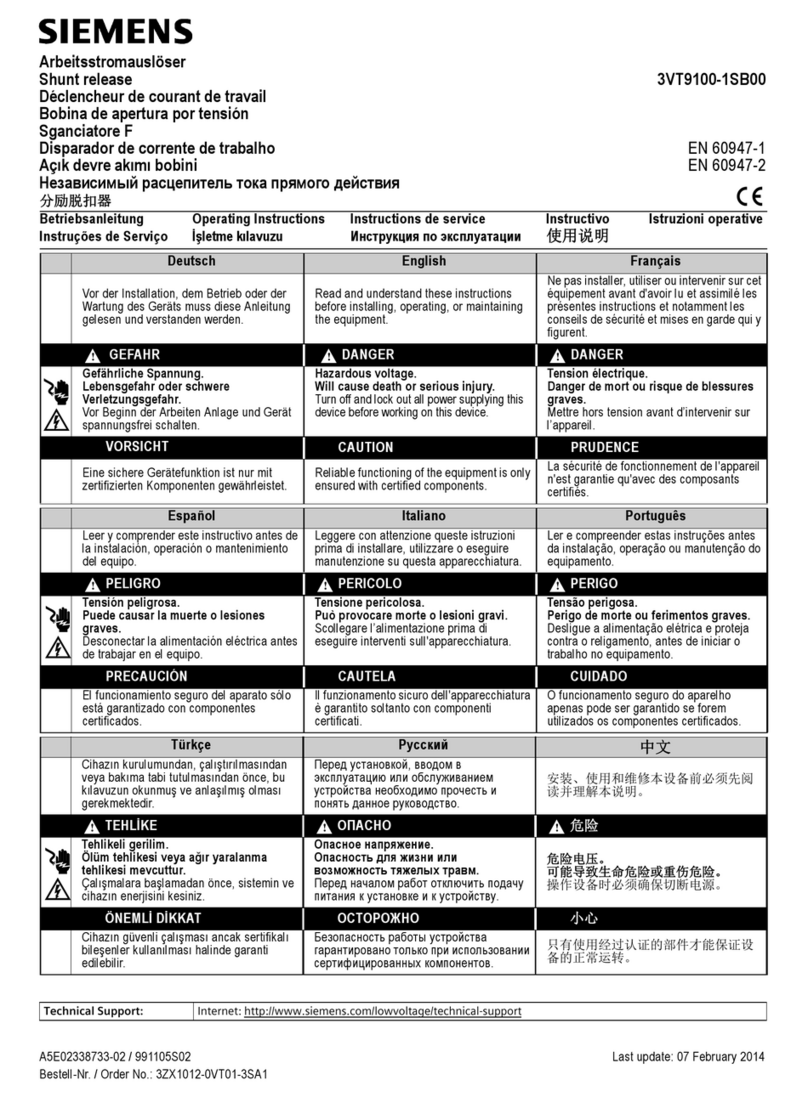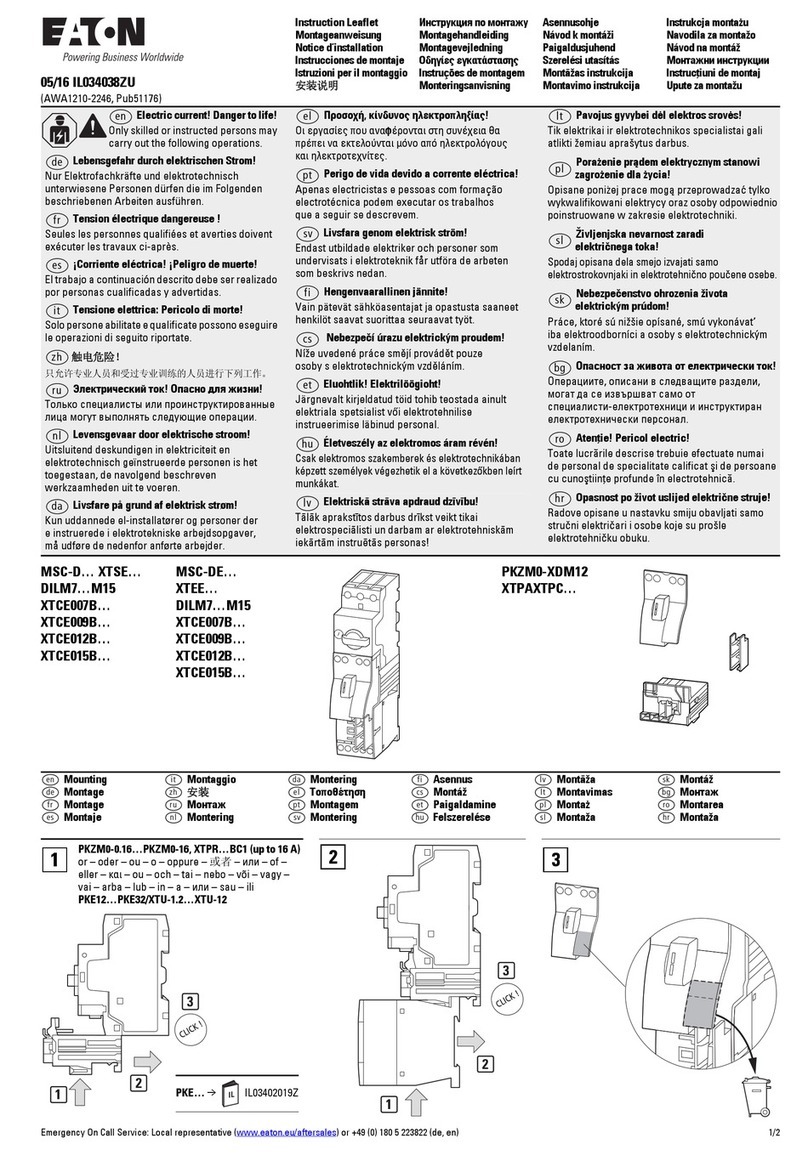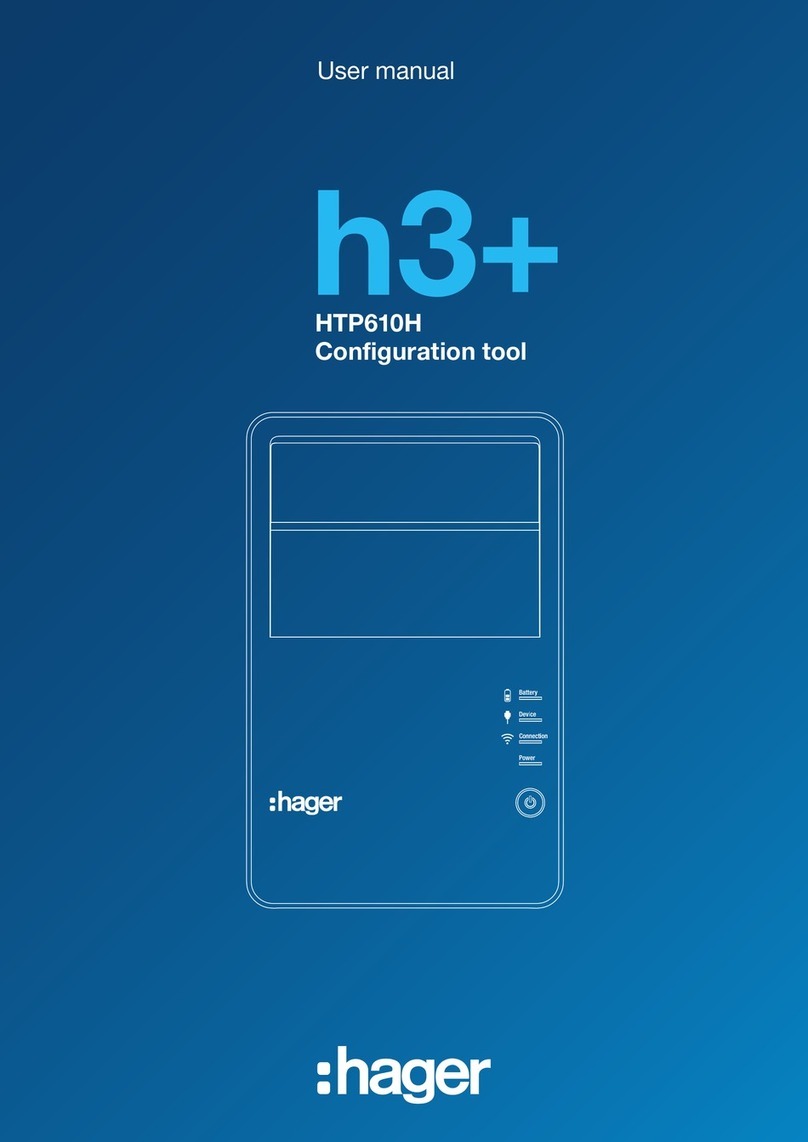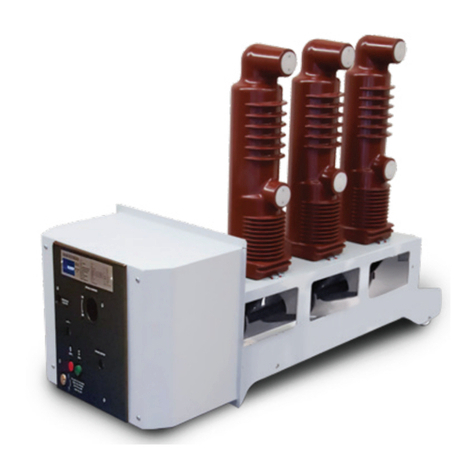Gould K-3000 User manual

p
*
1
;
Ju
,
l
EG
01
0
E
:
33
p
IB
‘
9
J
;
£
^
P
8
GOULD
i
-
T
-
E
LOW
-
VOLTAGE
POWER
CIRCUIT
BREAKERS
—
INSTRUCTIONS
v
*
•
f
f
:
:
.
r
.
V
-
7
V
x
:
;
-
-
—
>
TYPE
K
-
3000
,
K
-
4000
,
K
-
3000
S
,
K
-
4000
S
CIRCUIT
BREAKERS
t
Stationary
Switchboard
Mounted
and
Drawout
Mounted
\
mj
*
'
;
lip
PPH
m
TM
#
Of
Pages
v
Kobirt
:
'
io
:
>
GOULD
OUDHXJa
h
<
\
r
&
I
-
3
ls
/
o
Go
-
/
Dep
Fax
:
Phone
:
Phone
:
Note
:
E
-
Mail
:
Courtesy of store.ips.us

p
.
2
Jul
26
01
02
:
33
p
.
IB
-
91.7
-
4
GOULD
1
-
T
-
E
LOW
-
VOLTAGE
POWER
CIRCUIT
BREAKERS
PAGE
2
(
CONTENTS
Pag
©
Introduction
Receiving
and
Storage
.
Basic
Handling
instructions
Circuit
Breaker
Operation
Circuit
Breaker
Rating
Casing
Spring
Operation
Escutcheon
Operating
Features
Grcuit
Breaker
Nameplate
Manual
Charging
Handle
Manual
Trip
Button
.
„
.
Circuit
Breaker
“
Open
”
or
“
Closed
1
*
Indicator
Automatic
Trip
Indicator
Automatic
Trip
Alarm
Contacts
.
„
,
.
.
.
Automatic
Trip
lockout
.
Padlocking
Device
Closing
Spring
Charge
Indicator
Motor
Disconnect
Switch
Electrical
Close
Push
Button
Manual
Close
lever
Racking
Mechanism
(
Drawout
Breaker
)
Operation
of
Devices
.
Electro
-
Mechanical
Overcurrent
Trip
Devices
Power
Shield
Solid
State
Overcurrent
Trip
Devices
.
.
Control
Relay
*
«
Auxiliary
Switches
„
.
Undervoltage
Trip
Device
.
.
.
.
Installation
,
Initial
Testing
and
Removal
,
.
..
Installation
*
*
t
.
.
Checking
Grcuit
Breaker
Operation
Manual
Closing
Operation
.
..
Circuit
Breaker
Removal
(
Drawout
Type
)
Maintenance
and
Adjustments
Safety
Notes
Periodic
Maintenance
Inspection
*
Arc
Chutes
Insulation
Structure
.
Contacts
.
.
.
,
Contact
Pitting
.
Contact
Pressure
Check
and
Adjustment
,
.
>
Manual
Slow
Close
to
Check
Contact
Pressure
.
..
.
.
..
Operating
Mechanism
,
*
Primary
Trip
Latch
Tripper
Bar
Adjustment
Primary
Close
latch
.
Shunt
Trip
Device
Magnetic
latch
Device
Electro
-
Mechanical
Overcurrent
Trip
Device
Adjustments
Solid
State
Overcurrent
Trip
Device
Settings
.
.
lubrication
Dielectric
Test
Electrical
Characteristics
of
Control
Devices
/
Renewal
Parts
„
3
3
3
3
3
3
5
5
5
5
5
5
5
5
5
5
6
6
6
6
6
6
6
8
8
8
8
9
9
9
9
10
10
10
10
10
TO
10
10
11
13
13
13
13
13
13
14
15
15
15
16
16
Courtesy of store.ips.us

p
.
3
Jul
26
01
02
:
33
p
IB
-
9.1
.
7
-
4
GOULD
I
-
T
-
E
LOW
-
VOLT
AGE
POWER
CIRCUIT
BREAKERS
PAGE
3
v
.
-
INSTRUCTIONS
FOR
TYPE
K
-
3000
,
K
-
4000
,
K
-
300
OS
,
K
-
4
GQ
0
S
CIRCUIT
BREAKERS
Stationary
Switchboard
Mounted
and
Drawout
Mounted
INTRODUCTION
Circuit
breakers
should
be
installed
in
their
perma
-
nent
location
as
soon
as
possible
.
{
See
Basic
Handling
below
.
)
If
the
breakers
are
not
to
be
placed
in
service
for
some
time
,
it
is
advisable
to
provide
adequate
means
of
protection
.
This
may
be
done
by
keeping
the
breaker
on
its
original
skid
,
covering
with
waterproof
paper
and
sealing
to
prevent
infiltration
of
dirt
.
Where
conditions
of
high
humidity
prevail
,
the
use
of
heaters
is
recom
-
mended
.
These
instructions
apply
to
the
type
K
-
300
Q
and
K
-
4000
,
K
-
3000
S
and
K
-
4000
S
circuit
breakers
;
3000
and
4000
ampere
ac
continuous
current
rating
respec
-
tively
.
The
type
K
-
3000
and
K
-
4000
are
equipped
with
electromechanical
overcurrent
trip
devices
,
whereas
the
type
K
-
3000
S
and
K
-
4000
S
incorporate
the
solid
state
overcurrent
trip
devices
.
A
K
-
3000
S
circuit
breaker
is
shown
on
the
front
cover
of
this
bulletin
.
The
K
-
3000
and
K
-
4000
circuit
breakers
can
be
fur
-
nished
with
two
or
three
poles
for
dc
or
ac
operation
.
K
-
3000
S
and
K
-
4000
S
circuit
breakers
are
only
fur
-
nished
for
three
pole
ac
operation
.
All
circuit
breakers
can
be
furnished
as
drawout
or
stationary
mounted
and
are
available
as
manually
or
electrically
operated
,
and
with
electrical
control
devices
available
in
various
ac
and
dc
voltage
combinations
.
Many
optional
features
are
also
available
.
An
electrical
operated
,
drawout
type
circuit
breaker
is
shown
in
Figure
1
,
with
a
typical
schematic
diagram
shown
in
Figure
2
*
These
instructions
should
be
read
thoroughly
before
handling
,
installing
and
/
or
operating
the
circuit
breaker
.
BASIC
HANDLING
INSTRUCTIONS
Once
the
circuit
breaker
has
been
unbolted
and
re
-
moved
from
its
shipping
skid
,
it
should
be
turned
to
the
upright
position
and
placed
on
a
fiat
surface
to
avoid
damage
to
breaker
parts
.
For
safety
,
all
handling
In
this
position
should
utilize
the
lifting
yoke
(
20
)
shown
in
Figure
1
.
CIRCUIT
BREAKER
OPERATION
CIRCUIT
BREAKER
RATING
The
K
-
3000
/
K
-
3000
S
and
K
-
4000
/
K
-
4000
S
circuit
breakers
are
designed
to
carry
a
maximum
ac
contin
-
uous
current
of
3000
amperes
and
4000
amperes
re
-
spectively
,
Exceeding
these
ratings
may
raise
the
tem
-
perature
of
the
breakers
beyond
their
design
limit
and
thus
affect
the
life
of
the
breaker
.
Thus
,
any
long
-
time
pickup
setting
exceeding
100
%
of
the
frame
size
is
to
be
used
only
for
coordination
,
not
for
carrying
increased
continuous
current
.
RECEIVING
AND
STORAGE
immediately
upon
receipt
of
the
circuit
breakers
,
ex
-
amine
the
cartons
to
determine
if
any
damage
or
loss
was
sustained
during
transit
*
If
injury
or
rough
handling
is
evident
,
file
a
damage
claim
at
once
with
the
carrier
and
promptly
notify
Gould
Inc
.
Gould
Inc
.
is
not
responsible
for
damage
of
goods
after
delivery
to
the
carrier
.
However
,
Gould
Inc
.
will
lend
assistance
if
notified
of
daims
CLOSING
SPRING
OPERATION
The
two
dosing
springs
supply
the
power
that
closes
the
drcuit
breaker
and
also
charge
the
two
opening
springs
during
the
dosing
operation
.
The
closing
springs
are
charged
by
a
motor
in
the
electrically
operated
breaker
and
charged
by
hand
in
the
manually
operated
breaker
;
however
,
in
either
type
,
the
springs
are
charged
the
same
amount
and
when
charged
,
the
spring
energy
is
available
to
close
the
breaker
,
thus
referred
to
as
“
stored
energy
/
*
The
dosing
springs
are
normally
charged
when
the
breaker
i s
opened
.
If
charged
after
dosing
,
the
breaker
may
be
opened
and
then
redosed
without
recharging
the
springs
*
In
drawout
breakers
,
the
dosing
springs
are
automatically
dis
-
charged
when
the
breaker
is
moved
from
the
dis
-
connected
to
the
withdrawn
position
(
shown
in
Figure
1
)
.
This
prevents
accidental
discharge
.
Unpack
the
circuit
breakers
as
soon
as
possible
after
receipt
.
If
unpacking
is
delayed
,
difficulty
may
be
experi
-
enced
in
making
a
claim
for
damages
not
evident
upon
receipt
Use
care
in
unpacking
in
order
to
avoid
damaging
any
of
the
circuit
breaker
parts
.
Check
the
contents
of
each
carton
against
the
packing
list
before
discarding
any
packing
material
*
If
any
shortage
of
material
is
discovered
,
promptly
notify
the
nearest
representative
of
Gould
*
Information
specifying
the
purchase
order
number
,
carton
number
and
part
numbers
of
the
damaged
or
missing
parts
should
accompany
the
claim
.
These
instructions
do
not
purport
to
cover
all
details
or
variations
in
equipment
nor
to
provide
for
every
possible
contingency
to
be
met
in
connection
with
installation
,
operation
,
or
maintenance
.
Should
further
information
be
desired
or
should
particular
problems
arise
which
are
not
covered
sufficiently
for
the
purchaser
'
s
purposes
the
matter
should
be
referred
to
Gould
Inc
.
Courtesy of store.ips.us

Jul
26
01
02
:
33
p
P
*
4
-
IB
-
9.1
.
7
-
4
GOULD
l
-
T
*
E
LOW
-
VOLTAGE
POWER
CIRCUIT
BREAKERS
PAGE
4
V
r
*
t
*
*
o
:
;
rV
•
r
*
.
V
y
L
Arc
Chute
2
.
Arc
Chute
Retainer
Voiding
3
,
Arc
Chute
Mounting
Screw
*
4
*
Shutter
*
5
»
Visual
Indicator
for
Breaker
"
Closed
"
or
"
Opened
"
6
.
Manual
Close
lever
7
.
Manual
Charging
Laver
6
,
Manual
Trip
Button
3
*
Automatic
Trip
Indicator
10
*
Motor
Sisccnnect
Switch
21
.
Closing
Spring
Charging
Motor
22
.
Electrical
Close
Button
23
.
Locking
Hasp
24
.
Auxiliary
Switch
25
-
Nameplate
26
.
Plate
11
.
Spring
Retainer
Bracket
12
.
Manual
Charge
Handle
13
.
Racking
Crank
14
.
Closing
Spring
Charge
Indicator
15
.
Brawout
Lever
16
.
Racking
Cam
Rollers
17
.
Racking
Crank
Opening
18
.
Wheels
*
19
.
Shutter
Lock
Screw
(
Inserted
in
Shutter
)
20
.
Lifting
Yoke
*
Kot
Visible
in
This
View
Fig
.
1
—
Typical
Electrically
Operated
,
Drawout
Type
K
<
-
3000
Circuit
Breaker
Courtesy of store.ips.us

Jul
26
01
02
:
34
p
p
.
5
B
-
9
.
L
7
-
4
GOULD
l
-
T
-
E
LOW
-
VOLTAGE
POWER
CIRCUIT
BREAKERS
PAGE
5
This
device
is
an
indicator
only
and
does
not
prevent
the
circuit
breaker
reclosing
.
Upon
an
overcurrent
trip
operation
,
the
indicator
protrudes
from
the
front
plate
approximately
%
inch
.
The
automatic
trip
indicator
should
be
reset
after
each
trip
indication
by
pushing
back
into
its
normal
latch
position
.
The
operator
should
investigate
the
cause
of
tripping
before
resetting
the
automatic
trip
indicator
and
subsequent
redosing
the
drcuit
breaker
after
an
outage
which
results
in
an
operation
of
the
indicator
.
Automatic
Trip
Alarm
Contacts
(
Hand
Reset
)
{
Figure
1
,
Item
9
)
An
alarm
switch
for
remote
electrical
indication
,
which
is
optional
,
shows
when
automatic
tripping
has
occurred
.
This
is
accomplished
by
adding
a
precision
snap
switch
to
the
automatic
trip
indicator
assembly
.
The
automatic
trip
indicator
actuates
the
roller
on
the
alarm
switch
which
in
turn
causes
a
normally
open
contact
to
dose
and
a
normally
closed
contact
to
open
on
overcurrent
trip
.
The
alarm
contact
is
manually
reset
by
pushing
the
trip
indicator
(
9
)
back
into
its
normal
position
.
Automatic
Trip
Lockout
(
Hand
Reset
)
(
Figure
1
,
Item
9
)
An
additional
device
(
which
is
also
optional
)
may
be
added
to
the
automatic
trip
indicator
assembly
de
-
vice
which
serves
to
mechanically
prevent
recfosing
the
drcuit
breaker
after
an
automatic
trip
operation
.
When
the
trip
indicator
is
pushed
in
the
drcuit
breaker
mechanism
can
then
be
operated
to
close
the
circuit
breaker
contacts
.
Padlocking
Device
(
Figure
1
,
Item
23
}
All
K
-
fine
drcuit
breakers
are
equipped
with
means
of
padlocking
the
drcuit
breaker
mechanism
in
a
trip
-
free
position
.
This
Is
accomplished
by
the
use
of
a
locking
plate
to
maintain
the
manual
trip
button
in
a
tripping
direction
when
the
locking
plate
is
held
for
-
ward
by
one
or
more
padlocks
.
To
obtain
the
condi
-
tion
for
padlocking
the
drcuit
breaker
in
the
open
position
,
the
manual
trip
button
is
pushed
inward
.
Then
the
padlock
plate
is
pulled
out
and
the
padlock
in
-
serted
Into
the
vertical
slot
.
In
this
position
,
the
mechan
-
ism
is
maintained
trip
free
and
the
contact
arm
cannot
be
moved
to
the
dosed
position
.
On
circuit
breakers
equipped
with
drawout
mechanism
,
the
padlocking
device
is
associated
with
the
drawout
interlocking
mechanism
so
that
the
drcuit
breaker
can
-
not
be
moved
from
any
of
its
three
basic
drawout
posi
-
tions
of
“
CONNECTED
/
*
“
TEST
”
or
''
DISCONNECTED
with
the
padlocking
in
effect
.
Closing
Spring
Charge
Indicator
(
Bgure
1
,
Item
14
]
Under
normal
operating
conditions
,
the
closing
springs
are
automatically
charged
after
each
tripping
operation
.
However
,
there
are
occasions
when
the
springs
will
be
in
a
discharged
state
.
Therefore
,
it
is
desirable
that
means
be
available
to
indicate
the
charged
or
uncharged
condition
of
the
closing
springs
.
This
is
accomplished
by
a
visual
indicator
seen
through
an
aperture
in
the
escutcheon
plate
.
The
indicator
is
marked
“
CHARGED
”
and
“
UNCHARGED
/
*
ESCUTCHEON
OPERATING
FEATURES
Manually
and
electrically
operated
circuit
breakers
are
provided
with
an
extendible
escutcheon
face
plate
.
This
escutcheon
provides
a
central
area
for
the
controls
which
are
mounted
directly
on
the
circuit
breaker
.
The
controls
for
manually
operated
drcuit
breakers
,
Figure
1
,
included
in
the
escutcheon
face
plate
are
:
(
25
)
a
nameplate
giving
the
various
ratings
assigned
to
the
particular
type
of
drcuit
breaker
,
(
12
)
the
manual
charging
handle
,
(
8
)
the
manual
trip
button
,
(
5
)
the
“
OPEN
”
and
“
CLOSED
”
position
indicator
,
(
9
)
the
automatic
trip
indicator
with
optional
facilities
for
alarm
indication
and
for
lockout
,
(
23
)
a
means
for
padlocking
the
drcuit
breaker
in
the
“
CONNECTED
/
'
“
TEST
”
or
“
DISCONNECTED
”
positions
,
and
(
14
}
clos
-
ing
spring
charging
indicator
.
The
controls
for
the
electrically
operated
circuit
breakers
.
Figure
]
,
are
the
same
as
the
manually
oper
-
ated
circuit
breakers
except
the
charging
handle
(
12
)
is
removed
and
stored
for
maintenance
use
,
and
the
presence
of
(
10
}
motor
disconnect
switch
for
the
motor
electrical
circuit
and
(
22
)
electrical
dose
push
button
switch
.
The
manually
and
electrically
operated
drawout
dr
-
cuit
breaker
escutcheon
also
contains
the
racking
crank
opening
(
17
}
and
interlocking
drawout
lever
(
15
)
.
A
self
-
aligning
plate
,
immediately
behind
the
es
-
cutcheon
face
plate
,
is
used
to
exclude
dust
from
the
drcuit
breaker
compartment
.
On
drawout
type
drcuit
breakers
,
the
escutcheon
face
will
protrude
through
the
front
door
of
the
compartment
when
the
drcuit
breaker
is
in
the
“
TEST
”
and
“
DISCONNECTS
)
“
posi
-
tions
.
in
these
positions
,
the
dustplate
still
functions
to
exdude
dust
.
Circuit
Breaker
Nameplate
(
Figure
1
,
Item
25
)
The
drcuit
breaker
nameplate
contains
Information
regarding
(
I
)
the
manufacturers
name
and
address
,
(
2
}
type
of
drcuit
breaker
design
,
(
3
)
serial
number
of
circuit
breaker
,
(
4
)
continuous
current
rating
of
frame
size
,
(
5
)
short
drcuit
current
rating
at
rated
voltages
,
(
6
)
frequency
,
(
7
)
short
time
current
.
Manual
Charging
Handle
(
Figure
1
,
item
12
}
The
manual
charging
handle
is
a
T
-
shaped
fever
used
to
charge
the
closing
springs
by
pumping
approxi
-
mately
ten
times
.
Manual
Trip
Button
(
Figure
1
,
Item
8
)
The
manual
trip
button
,
when
pushed
,
trips
the
dr
-
cuit
breaker
to
“
OPEN
/
1
Circuit
Breaker
“
OPEN
"
or
“
CLOSED
”
Indicator
(
Figure
T
,
Hem
5
)
This
indicator
shows
the
physical
position
of
the
drcuit
breaker
contacts
.
Automatic
Trip
Indicator
(
Figure
I
,
Item
9
)
(
Not
induding
undervoltage
,
alarm
switch
or
lockout
)
The
automatic
trip
indicator
is
provided
as
standard
equipment
on
the
K
-
line
^
drcuit
breakers
and
h
used
to
indicate
the
operation
of
the
overcurrent
trip
device
.
Courtesy of store.ips.us

Jul
26
01
Q
2
:
34
p
p
.
6
IB
-
91.7
-
4
GOULD
l
-
T
-
E
LOW
-
VOLTAGE
POWER
CIRCUIT
BREAKERS
PAGE
S
device
must
be
properly
set
to
provide
adequate
pro
-
tection
for
an
electrical
system
.
Three
adjustment
screws
on
the
bottom
of
the
device
provide
independent
con
-
trol
of
the
long
-
time
pickup
,
instantaneous
pickup
and
amount
of
time
delay
.
The
nameplate
of
this
device
shows
the
setting
of
these
adjustments
and
the
range
of
settings
which
are
available
.
For
information
on
the
time
-
current
characteristics
of
this
device
,
request
a
copy
of
TD
-
6693
.
(
B
)
Type
OD
-
400
Selective
Overcurrent
Trip
Device
.
The
type
OD
-
400
overcurrent
trip
device
,
for
selective
tripping
applications
,
provides
long
-
time
delay
and
short
-
time
delay
tripping
.
Independent
adjustment
of
both
pickup
and
time
delay
is
provided
for
both
types
of
tripping
.
The
nameplate
of
this
device
shows
the
settings
which
are
available
.
For
information
on
the
time
-
current
characteristics
of
this
device
,
request
a
copy
of
TD
-
6694
.
(
C
)
See
Table
1
for
complete
list
of
Eleciro
-
Mechan
-
icai
overcurrent
trip
devices
available
.
'
'
“
Motor
Disconnect
Switch
(
Figure
I
,
Item
101
{
The
motor
disconnect
switch
is
a
double
pole
,
single
-
throw
toggle
type
switch
connected
in
series
with
the
charging
motor
circuit
and
is
used
to
disconnect
the
motor
from
the
voltage
source
.
This
switch
is
used
(
1
)
,
when
it
is
desirable
to
prevent
automatic
recharging
of
the
closing
springs
fust
prior
to
taking
the
circuit
breaker
out
of
service
for
maintenance
and
(
2
)
,
for
control
wiring
dielectric
test
.
The
motor
must
be
dis
-
connected
for
the
control
wiring
dielectric
test
and
subsequently
tested
at
540
V
ac
or
760
V
dc
.
Electrical
Close
Push
Button
{
Figure
1
,
Item
22
)
The
electrical
dose
push
button
is
used
to
electrically
dose
the
drcuit
from
the
escutcheon
.
This
contact
is
connected
in
series
with
the
latch
release
coil
.
Energiz
-
ing
the
latch
release
coil
allows
the
charged
springs
to
close
the
circuit
breaker
.
Manual
Close
Lever
(
Figure
1
,
Item
6
)
The
manual
dose
lever
is
provided
on
all
drcuit
breakers
to
provide
a
safe
means
of
dosing
the
breaker
without
control
power
.
The
lever
is
provided
with
a
ring
to
which
a
lanyard
should
be
attached
for
closing
the
breaker
at
a
safe
distance
.
Racking
Mechanism
(
Drawout
Breaker
)
The
racking
mechanism
is
used
to
move
the
drcuit
^
breaker
to
any
one
of
its
three
positions
—
"
CON
-
NECTED
/
'
"
TEST
”
or
"
DISCONNECTED
,
”
All
of
these
^
positions
are
attainable
with
the
cubicle
door
dosed
or
opened
.
The
breaker
can
be
dosed
only
when
the
drawout
lever
(
15
,
Figure
1
)
is
up
and
when
up
,
the
racking
crank
{
13
,
Figure
1
)
cannot
be
turned
.
The
drcuit
breaker
must
be
in
the
“
OPEN
"
position
before
lever
(
15
,
Figure
]
)
can
be
pushed
down
,
in
order
to
move
the
drcuit
breaker
from
one
position
to
another
,
the
lever
must
be
pushed
down
and
the
crank
turned
;
once
turning
begins
,
the
lever
will
stay
down
until
another
position
is
reached
and
the
lever
will
snap
up
,
preventing
additional
turning
,
until
the
leyer
is
again
pushed
down
.
When
the
padlocking
device
is
locked
,
the
lever
{
15
)
is
locked
in
the
up
position
preventing
movement
of
the
racking
mechanism
.
Figure
1
shows
the
breaker
in
the
fully
withdrawn
position
.
There
are
two
sets
of
indicator
lines
on
the
left
side
of
the
breaker
to
show
breaker
position
.
One
set
is
visible
with
the
switchboard
door
dosed
,
the
other
visible
when
the
door
is
open
.
Power
Shield
Solid
State
Overcurrent
Trip
Devices
Type
K
-
3000
S
and
K
-
40005
Circuit
Breakers
(
See
Figure
12
)
This
device
includes
the
power
supply
sensors
,
over
-
current
sensors
,
Power
Shield
solid
state
logic
assembly
,
magnetic
latch
and
the
interconnecting
wiring
.
Each
phase
of
the
circuit
breaker
has
a
power
supply
sensor
and
overcurrent
sensor
.
The
trip
elements
that
are
avail
-
able
are
:
long
-
time
delay
,
instantaneous
,
short
-
time
delay
and
ground
fault
.
On
a
3
-
phase
4
-
wire
system
,
an
additional
remote
sensor
,
mounted
in
the
neutral
bus
,
is
required
for
complete
ground
fault
protection
.
The
logic
assembly
is
mounted
near
the
front
of
the
circuit
breaker
and
with
the
cubide
door
open
the
OYercurrent
control
panel
is
readily
accessible
,
device
must
be
properly
set
,
as
required
by
individual
circuit
conditions
,
to
provide
adequate
protection
for
an
electrical
system
.
The
movable
plugs
on
the
control
pane
!
provide
independent
control
of
the
long
-
time
,
short
-
time
,
instantaneous
and
ground
fault
pickup
and
amount
of
time
delay
.
The
overcurrent
device
,
with
the
exception
of
ground
fault
,
will
trip
at
the
value
of
the
AMPERE
TAP
setting
times
the
plug
setting
of
the
various
pickup
elements
.
The
ground
fault
trip
value
will
be
the
plug
setting
value
times
100
,
as
indicated
on
the
nameplate
.
(
A
)
Type
5
S
-
3
.
This
trip
device
is
for
general
pur
-
pose
application
.
It
provides
long
-
time
delay
tripping
on
moderate
overcurrents
,
which
are
above
the
long
-
time
pickup
settings
,
and
instantaneous
tripping
on
fault
currents
above
the
instantaneous
trip
setting
.
For
infor
-
mation
on
the
time
-
current
characteristics
of
this
device
,
request
a
copy
of
TD
-
6966
(
TD
-
90
Q
1
*
)
.
(
B
)
Type
SS
-
4
Selective
Overcurrent
Trip
Device
.
This
trip
device
,
for
selective
tripping
application
,
pro
-
vides
long
-
time
delay
and
short
-
time
delay
tripping
.
For
information
on
the
time
-
current
characteristics
of
this
device
,
request
a
copy
of
TD
-
6967
(
TD
-
9002
*
)
.
(
C
)
Type
SS
-
5
Triple
-
Selective
Overcurrent
Trip
De
-
vice
.
This
device
includes
the
trip
elements
found
in
both
the
5
S
-
3
and
SS
-
4
;
i
.
e
.
,
long
-
time
delay
,
short
-
time
?
.
?
:
This
OPERATION
OF
DEVICES
Electro
-
Mechanical
Overcurrent
Trip
Devices
Type
K
-
3000
and
K
-
4000
Circuit
Breakers
(
Figures
10
and
11
)
(
A
)
Type
OD
-
300
General
Purpose
Overcurrent
Trip
Jr
Device
.
The
type
OD
-
300
overcurrent
trip
device
,
for
general
purpose
applications
,
provides
long
-
time
delay
tripping
on
moderate
overcurrents
which
are
above
the
long
-
time
pickup
setting
;
and
instantaneous
tripping
on
fault
currents
above
the
instantaneous
trip
setting
.
This
Courtesy of store.ips.us

Jul
26
01
02
:
35
p
t
P
*
7
18
-
9.1
.
7
-
4
GOULD
i
-
T
-
E
LOW
-
VOLTAGE
POWER
CIRCUIT
BREAKERS
PAGE
7
are
designated
by
the
types
SS
-
3
G
,
SS
-
4
G
and
SS
-
5
G
.
For
information
on
the
time
current
characteristics
of
this
feature
,
request
a
copy
of
TD
-
6968
(
TD
-
9005
*
)
.
(
E
)
See
Tabfe
1
A
for
a
complete
list
of
standard
Solid
State
oyercurrent
trip
devices
.
delay
,
and
instantaneous
tripping
.
For
information
on
the
time
-
current
characteristics
of
this
device
,
request
a
copy
of
TD
-
6967
(
10
-
9002
*
]
.
CD
)
The
above
three
solid
state
overcurrent
trip
devices
are
available
with
ground
fault
protection
and
TABLE
I
STANDARD
ELECTRO
-
MECHANICAL
OYERCURRENT
TRIP
DEVICES
Trip
Element
Time
-
Current
Characteristic
Curve
Overcurrent
Devica
Type
Instan
-
taneous
Short
-
Time
Long
-
Time
TD
-
6693
X
OD
-
3
QO
X
0
B
-
4
G
0
X
TO
-
6594
X
X
TO
-
6695
00
-
500
X
X
TD
-
6695
X
00
-
600
X
X
None
0
D
-
700
X
00
-
800
None
TB
-
6699
X
X
0
D
-
9
QQ
X
TB
-
6699
00
-
1000
NOTE
:
00
-
300
long
-
time
delay
element
has
one
time
delay
band
only
.
All
other
long
-
time
A
short
-
time
delay
elements
have
three
time
delay
bands
.
•
<
•
>
•
*
v
.
TABLE
IA
STANDARD
SOLID
STATE
OYERCURRENT
TRIP
OEYICES
Time
-
Current
Characteristic
Curve
Trip
Element
Overcurrent
Devica
Type
Device
in
REO
CASE
Device
in
GRAY
CASE
*
Short
-
Time
Long
-
Time
Instan
-
taneous
Ground
SS
-
3
TD
-
6966
T
0
-
9001
X
X
TD
-
6966
TD
-
6968
TB
-
9001
TD
-
9005
SS
-
3
G
X
X
X
SS
-
4
TD
-
6967
TD
-
9002
X
X
TD
-
6967
TD
-
6968
TD
-
9002
TD
-
9005
SS
-
4
G
X
X
X
SS
-
5
TD
-
6967
TD
-
9002
XX
X
TD
-
6967
TO
-
6968
T
0
-
9
Q
02
TD
-
9005
SS
-
5
G
X
X
X
X
NOTE
:
Time
-
current
characteristic
curves
are
not
included
in
this
book
because
separate
coordination
curves
are
normally
provided
with
each
order
.
When
field
calibration
is
performed
,
necessary
instruction
books
(
refer
to
page
15
)
will
be
provided
and
will
include
all
pertinent
timing
information
.
*
Device
in
GRAY
CASE
(
Current
Manufacture
)
TD
-
6966
,
TD
-
6967
&
TD
-
6968
apply
to
Device
in
RED
CASE
Courtesy of store.ips.us

Jul
26
01
02
:
36
p
p
,
8
18
-
9
,
1.7
-
4
GOULD
l
-
T
-
E
LOW
-
VOLTAGE
POWER
CIRCUIT
BREAKERS
PAGE
8
/
*
S
:
nlshed
either
for
instantaneous
trip
operation
or
with
adjustable
time
delay
tripping
of
0
-
15
seconds
*
The
undervoltage
trip
device
is
an
integral
unit
which
may
be
added
to
the
circuit
breaker
either
at
the
factory
or
in
the
field
*
The
undervoltage
device
may
be
connected
so
that
the
automatic
trip
indicator
(
Figure
1
,
Item
9
)
will
pro
-
trude
from
the
front
plate
when
the
breaker
is
tripped
by
the
undervoltage
device
*
See
Table
4
f
page
16
,
for
electrical
characteristics
.
^
^
ontrol
Relay
This
device
is
contained
in
the
black
insulated
mold
-
ing
,
3
"
X
5
"
X
6
"
approximate
,
located
at
the
lower
front
of
the
mechanism
and
is
used
on
all
electrically
operated
mechanisms
.
The
52
Y
coil
,
and
contacts
52
Y
/
7
,
52
Y
/
2
are
connected
as
shown
in
the
schematic
dia
-
gram
,
Figure
2
.
The
purpose
of
this
device
is
to
require
that
,
if
the
remote
or
local
dose
contacts
are
dosed
,
resulting
in
the
charging
springs
discharging
,
the
dose
contacts
must
first
be
released
(
opened
!
before
the
breaker
can
be
reclosed
*
This
prevents
dosing
the
breaker
more
than
one
time
unless
the
dose
contacts
are
first
released
.
Auxiliary
Switches
The
auxiliary
switches
[
24
,
Figure
1
)
contain
the
Ma
,
f
and
"
b
"
contacts
(
Figure
2
)
and
are
furnished
in
4
or
8
contact
arrangements
*
They
are
mechanically
intercon
-
nected
with
the
main
breaker
contacts
such
that
,
with
the
breaker
dosed
,
the
“
a
”
contacts
are
dosed
*
With
the
circuit
breaker
open
,
the
contacts
are
closed
.
Undervoltage
Trip
Device
The
electrically
reset
undervoltage
trip
device
is
a
single
-
phase
device
which
automatically
trips
the
drcuit
breaker
when
the
line
voltage
decreases
to
30
to
60
percent
of
the
rated
voltage
.
This
device
may
be
fur
-
V
INSTALLATION
,
INITIAL
TESTING
AND
REMOVAL
(
Drawout
&
Stationary
)
FOR
SAFETY
;
When
installing
or
removing
stationary
breakers
,
the
supply
for
primary
and
control
drcuits
must
be
de
-
energized
at
all
times
.
Testing
of
stationary
breakers
to
be
done
with
the
primary
supply
drcuit
de
-
energized
.
For
initial
installation
of
drawout
breakers
in
the
"
CONNECTED
’
*
position
,
the
supply
for
the
primary
dr
-
cuit
should
be
de
-
energized
.
Testing
of
the
drawout
breaker
to
be
done
in
the
test
position
.
NOTE
:
(
K
-
3000
and
K
-
4000
Circuit
Breakers
)
Prior
to
inserting
the
drcuit
breaker
into
the
switchboard
and
3
^
~
TRH
»
V
$
(
S
4
V
V
V
V
V
r
4
e
73
i
r
7
R
1
#
T
1
L
J
‘
T
*
1
L
a
T
IT
a
9
t
CLOSE
A
si
24
«
'
I
IS
2
47
3
r
;
i
L
T
«
I
C
3
«
«
6
IIGEK
3
«
3
i
St
2
*
Sd
ISO
DM
kjt
.
i
±
L
±
3
vr
_
8
-
Charging
Kotor
TC
-
Trip
Coil
80
S
-
Barging
Saior
Oiscotwect
Saitcli
IS
/
l
.
LS
/
3
-
Liflft
Su
ten
Contacts
Closed
»
en
Springs
art
fiisdiargsd
.
Cpen
Springs
nt
Barged
LS
/
2
-
Uait
Swi
left
Contacts
Open
then
Springs
are
Biscfcsrged
.
ClTOWt
Jfiiai
Springs
etc
Barged
l
/
a
-
Contact
Closed
SIM
Breaker
is
Closed
1
/
6
-
Contact
Open
TRiea
8
reaker
is
Cioseo
5
ZX
-
Lalcb
Release
Coi
l
52
T
-
Control
Coil
52
Y
/
I
-
LadHwi
Relay
Contact
,
fioroallj
Open
52
T
/
2
-
lockout
Relay
Contact
.
Jfcfoaiiy
Closed
4
J
130
-
<
ns
i
52
2
43
8
f
I
A
?
MU
CE
1
«
6
.
1
SZY
H
ICES
CE
3
i
?
ts
z
©
rro
C
1
*
L
2
i
|
CE
8
1
<
r
L
1
>
CCS
.
t
CC
2
CE
4
;
5
&
se
©
6
TC
El
Fee
6
71
CC
2
-
CC
4
L
&
7
S
2
jgo
&
8
53
A
A
A
S
3
TW
\
7
3
Z
STATIONARY
DRAWOUT
Fig
.
2
—
Typical
Schematic
Diagram
of
Control
Circuit
Courtesy of store.ips.us

Jul
26
01
02
:
3
Gp
p
*
9
IB
-
9.1
.
7
-
4
GOULD
l
-
T
-
E
LOW
-
VOLTAGE
POWER
CIRCUIT
BREAKERS
PAGE
3
e
.
Check
each
auxiliary
device
for
proper
operation
.
with
the
breaker
in
the
upright
position
,
exercise
the
three
tong
time
armatures
(
1
"
wide
armatures
)
several
times
until
resistance
to
motion
has
increased
,
indicating
that
the
oil
dashpot
is
functioning
properly
.
Improper
operation
can
result
because
the
circuit
breaker
is
shipped
or
stored
on
its
back
.
This
causes
the
oil
in
the
dashpot
to
be
displaced
and
an
air
bubble
can
be
trapped
under
the
piston
.
The
exercise
removes
the
air
to
permit
proper
operation
.
CHECKING
CIRCUIT
BREAKER
OPERATION
IN
“
TEST
”
POSITION
(
Manually
Operated
,
Drawout
Type
)
(
See
Figure
1
}
a
.
Manually
reset
automatic
trip
indicator
(
9
)
if
it
protrudes
approximately
W
'
•
.
Push
in
to
reset
.
b
.
Charge
and
dose
circuit
breaker
;
See
“
Manual
Closing
Operation
”
below
.
c
.
Trip
by
manual
"
TRIP
”
button
(
8
)
.
d
.
Check
each
auxiliary
device
for
proper
operation
.
INSTALLATION
(
Drawout
Type
)
(
See
Figure
I
}
The
circuit
breaker
must
be
in
the
“
OPEN
"
position
,
the
racking
crank
(
13
)
when
inserted
in
opening
(
17
)
is
rotated
counterdockwise
until
the
rocking
com
roller
(
16
)
is
rotated
down
into
a
45
°
angle
,
and
the
motor
disconnect
switch
(
10
)
for
electrically
operated
circuit
breakers
is
in
the
"
OFF
”
position
.
NOTE
:
Lever
(
15
)
must
be
pushed
down
to
permit
the
rotation
of
crank
(
13
)
.
Open
compartment
door
and
lower
the
right
and
left
hand
tracks
to
fully
extended
position
.
Use
lifting
yoke
(
20
r
Figure
T
)
,
which
is
inserted
in
holes
in
the
upper
rear
frame
,
and
lower
drcuif
breaker
wheels
(
18
)
onto
track
extensions
.
Remove
lifting
yoke
.
Push
drcuit
breaker
into
compartment
until
racking
cam
rollers
(
16
)
stop
against
their
guides
.
CAUTION
;
RAISE
TRACK
EXTENSION
INTO
COM
-
PARTMENT
BEFORE
RACKING
.
Insert
racking
crank
(
13
)
into
opening
(
17
)
and
depress
drawout
lever
(
15
)
,
Turn
crank
clockwise
until
automatically
stopped
.
Breaker
is
now
in
"
DISCON
-
NECT
"
position
.
An
.
arrow
on
the
left
side
of
plate
(
26
)
will
also
line
up
with
“
DISCONNECT
’
on
the
cradle
.
Again
depress
drawout
lever
(
15
)
and
turn
crank
clockwise
until
automatically
stopped
.
Breaker
is
now
in
“
TEST
"
position
.
CHECKING
CIRCUIT
BREAKER
OPERATION
IN
"
CON
-
NECTED
”
POSITION
(
Drawout
Type
)
After
completing
check
procedures
in
“
TEST
”
position
,
continue
as
follows
:
With
drcuit
breaker
in
"
OPEN
"
position
and
motor
disconnect
switch
(
10
)
in
“
OFF
’
*
position
,
insert
racking
crank
(
13
)
in
opening
(
17
)
and
press
down
drawout
lever
(
15
)
.
Rotate
the
racking
crank
clockwise
until
lever
(
15
)
moves
up
and
cranking
is
automatically
stopped
.
Breaker
is
now
in
“
CONNECTED
"
position
.
Excessive
cranking
force
indicates
misalignment
or
inter
-
ference
of
parts
.
CHECKING
CIRCUIT
BREAKER
OPERATION
(
Stationary
Type
)
Follow
the
same
procedure
as
for
drawout
drcuit
breaker
,
except
the
circuit
breaker
will
be
in
the
“
CON
-
NECTED
"
position
.
Primary
supply
drcuit
must
be
de
-
energized
.
MANUAL
CLOSING
OPERATION
The
following
manual
closing
procedures
are
recom
-
mended
:
(
See
Figure
1
)
a
.
Observe
drcuit
breaker
conditions
on
control
escutcheon
.
b
.
If
closing
springs
are
discharged
,
manually
charge
closing
springs
by
means
of
the
manual
charge
lever
(
12
)
then
pull
the
manual
dose
lever
(
6
)
by
a
lanyard
from
a
safe
distance
.
c
.
If
springs
are
charged
,
pull
the
manual
dose
lever
(
6
)
by
means
of
a
lanyard
from
a
safe
distance
.
d
.
For
partially
charged
closing
springs
,
should
dos
-
ing
not
occur
upon
pulling
the
manual
dose
lever
,
con
-
tinue
charging
until
dosing
springs
are
completely
charged
(
heard
to
snap
)
and
by
visual
indicator
(
14
)
,
then
pull
manual
dose
lever
(
6
)
by
means
of
a
lanyard
from
a
safe
distance
.
INSTALLATION
(
Stationary
Type
)
Lifting
yoke
(
20
)
should
be
used
to
move
the
breaker
to
the
switchboard
;
however
,
other
handling
means
will
be
required
to
move
the
breaker
into
position
inside
the
switchboard
.
CHECKING
CIRCUIT
BREAKER
OPERATION
IN
“
TEST
"
POSITION
(
Electrically
Operated
,
Drawout
Type
)
(
See
Figure
1
)
a
.
Manually
reset
automatic
trip
indicator
(
9
)
if
it
protrudes
approximately
Vz
”
.
Push
In
to
reset
.
b
.
Turn
motor
disconnect
switch
(
10
)
to
"
ON
"
posi
-
tion
and
closing
springs
will
automatically
charge
.
c
.
Close
drcuit
breaker
by
local
dose
button
and
trip
by
local
trip
button
.
NOTE
:
All
breakers
have
a
manual
trip
button
.
The
local
dose
button
for
electrical
breakers
is
standard
.
The
local
trip
button
for
electrical
breakers
?
s
optional
.
d
.
Close
and
trip
circuit
breaker
by
means
of
remote
control
switch
.
CIRCUIT
BREAKER
REMOVAL
(
Drawout
Type
)
(
See
Figure
1
)
a
.
Trip
circuit
breaker
by
any
tripping
means
.
b
.
Open
front
compartment
door
.
Courtesy of store.ips.us

.
Jul
EG
01
0
E
:
36
p
p
.
10
GOULD
I
T
-
E
LOW
-
VOLTAGE
POWER
CIRCUIT
BREAKERS
IB
-
9
,
1.7
-
4
PAGE
10
e
.
Engage
racking
crank
(
13
)
in
opening
(
17
)
and
push
drawout
lever
(
15
)
down
.
Rotate
racking
crank
counterclockwise
until
racking
mechanism
automatically
stops
at
“
TEST
”
position
,
tower
track
extensions
.
d
.
Repeat
step
“
C
”
to
rack
circuit
breaker
to
“
DIS
-
CONNECT
position
.
e
.
Depress
drawout
lever
(
15
)
and
continue
crank
-
ing
counterclockwise
as
far
as
stops
will
allow
.
{
Do
not
force
beyond
stops
.
)
f
.
Pull
circuit
breaker
forward
to
fully
extended
posi
-
tion
.
(
Should
the
circuit
breaker
be
charged
,
dosing
springs
will
automatically
be
discharged
at
this
point
.
)
g
.
Remove
drcuit
breaker
from
tracks
with
lifting
yoke
,
then
raise
tracks
into
compartment
and
dose
door
.
inspected
as
described
below
.
(
ARC
CHUTES
If
the
drcuit
breaker
has
a
solid
state
overcurrent
trip
device
,
it
is
necessary
to
remove
two
TA
"
diameter
screws
fastening
the
solid
state
control
assembly
,
so
that
the
control
assembly
can
be
moved
to
permit
removal
of
the
arc
chute
.
a
.
Remove
fwo
arc
chute
mounting
screws
(
3
,
Figure
1
)
and
retainer
molding
(
2
)
.
Uft
arc
chute
(
I
}
up
and
draw
out
.
b
.
Inspect
for
breakage
to
side
moldings
,
center
moldings
,
arc
plates
and
liner
plates
.
Check
for
pres
-
ence
of
foreign
particles
such
as
chips
of
moldings
and
metal
.
MAINTENANCE
AND
ADJUSTMENTS
INSULATION
STRUCTURE
SAFETY
NOTES
De
-
energize
both
primary
and
control
drcuifs
before
making
any
inspections
,
adjustments
or
replacements
of
parts
.
Make
certain
breaker
is
open
by
observing
indicator
(
5
,
Figure
1
)
,
and
closing
springs
are
not
charged
by
observing
indicator
(
14
,
Figure
1
)
.
When
it
is
necessary
that
the
charging
springs
be
charged
,
or
the
drcuit
breaker
be
dosed
,
make
sure
to
stay
dear
of
operating
parts
.
Stationary
breakers
should
be
checked
for
operation
Mv
-
O
^
h
the
control
circuit
energized
and
the
primary
power
^
Sae
-
energized
.
Drawout
breakers
should
be
withdrawn
to
“
TEST
*
position
for
checking
the
breaker
operation
.
For
further
inspection
,
adjustments
,
cleaning
or
replace
-
ment
of
parts
,
the
drawout
drcuit
breaker
should
be
withdrawn
and
moved
to
a
suitable
area
.
Stationary
breakers
should
likewise
be
removed
,
but
,
if
removal
is
not
possible
,
then
the
primary
and
control
drcuit
sources
MUST
BE
DE
-
ENERGIZED
.
Insulated
parts
should
be
checked
for
damage
.
Dust
and
dirt
should
be
removed
by
air
or
wiped
with
a
clean
lintless
doth
.
Do
not
use
any
oil
base
solvents
.
Spray
solvents
vary
as
to
type
and
are
questionable
.
However
,
externally
at
rear
terminals
is
the
only
critical
area
,
which
is
easily
wiped
or
blown
out
with
air
,
so
other
methods
are
not
necessary
.
If
contamination
is
so
great
,
means
are
probably
necessary
to
isolate
the
entire
equipment
.
CONTACTS
a
.
Remove
dirt
or
grease
on
contacts
with
a
clean
lintless
cloth
.
b
.
Discoloration
of
the
main
contacts
does
not
neces
-
sarily
indicate
damage
.
However
,
this
condition
may
be
removed
by
opening
and
dosing
the
circuit
breaker
under
no
-
load
conditions
.
CONTACT
PITTING
PERIODIC
MAINTENANCE
INSPECTION
The
safety
and
successful
functioning
of
the
con
-
nected
apparatus
depends
upon
the
proper
operation
of
the
drcuit
breaker
.
Therefore
,
it
is
recommended
that
a
maintenance
program
be
established
that
will
pro
-
vide
for
a
periodic
inspection
of
the
drcuit
breaker
after
250
no
load
or
load
cvrrent
switching
operations
.
If
250
operations
are
not
completed
in
the
first
year
of
service
,
the
drcuit
breakers
should
be
inspected
re
-
gardless
.
The
drcuit
breaker
should
also
be
inspected
after
a
short
drcuit
or
severe
overload
interruption
,
regardless
of
time
period
or
number
of
operations
.
Where
unusual
service
conditions
,
as
covered
by
AN
Standard
C
37
.
I
3
,
exist
,
it
must
be
assumed
that
these
conditions
were
considered
at
the
time
of
order
;
that
the
equipment
supplied
was
designed
for
the
special
application
;
and
that
an
appropriate
supplemental
jnainfenance
program
has
been
developed
.
These
main
-
<
^
ance
instructions
only
cover
drcuit
breakers
used
yfiffider
the
standard
usual
service
conditions
.
The
inspection
should
include
opening
and
closing
the
circuit
breaker
electrically
and
manually
.
The
unit
should
be
visually
inspected
for
loose
or
damaged
parts
.
Arc
chutes
,
contacts
and
insulation
structure
should
be
a
.
A
moderate
amount
of
pitting
will
not
interfere
with
the
operation
of
the
arcing
contacts
.
Should
it
be
necessary
to
dress
the
ardng
contacts
to
remove
small
burrs
,
cover
the
mechanism
with
a
doth
.
Follow
the
contour
of
the
contacts
with
light
wipes
of
a
fine
file
and
do
not
attempt
to
eliminate
pitting
entirely
.
When
finished
,
remove
doth
and
wipe
off
any
remaining
dirt
or
filings
.
Do
not
use
emery
cloth
or
the
like
for
sanding
contacts
.
The
material
deposits
affect
contin
-
uous
current
ability
adversely
.
b
.
Should
the
main
contacts
show
more
than
moder
-
ate
pitting
,
check
the
contact
pressure
.
CONTACT
PRESSURE
CHECK
AND
ADJUSTMENT
Jaw
Type
Arcing
Contacts
(
See
Figure
3
A
)
FOR
SAFETY
:
Keep
dear
of
breaker
parts
during
this
operation
.
a
.
Close
the
breaker
.
Lever
(
15
,
Figure
1
)
must
be
in
the
up
position
.
b
.
For
each
set
of
eight
contacts
on
one
pole
,
the
smallest
gap
“
A
”
should
be
.
100
-
.
105
inch
.
If
adjust
-
ment
is
required
,
loosen
lock
screw
(
2
)
.
Turn
adjust
-
ment
screw
(
1
)
until
.
100
-
.
105
is
obtained
on
the
Courtesy of store.ips.us

p
.
1 1
Jul
26
01
02
:
37
p
I
-
IB
-
9
JJ
-
4
GOULD
1
-
T
-
E
LOW
-
VOLTAGE
POWER
CIRCUIT
BREAKERS
PAGE
11
f
smallest
gap
of
the
eight
contacts
.
Repeat
this
for
the
other
two
poles
.
Tighten
lock
screw
(
2
)
.
Note
that
if
an
adjustment
is
necessary
for
“
simul
-
taneous
”
make
,
the
contact
pressure
will
increase
on
those
adjusted
poles
.
Thus
,
a
dimension
of
more
than
the
ranges
listed
above
indicates
more
contact
pressure
which
is
acceptable
.
f
.
To
remove
the
spring
retainer
bracket
(
111
,
push
the
manual
trip
button
(
8
)
to
trip
the
circuit
breaker
.
Continue
pumping
untii
closing
springs
are
again
heard
to
snap
.
Then
remove
spring
retainer
bracket
.
g
.
The
circuit
breaker
is
now
charged
and
ready
to
be
dosed
.
h
.
To
discharge
dosing
springs
,
pull
the
manual
dose
lever
(
6
)
and
push
manual
trip
button
(
8
)
.
i
.
Put
arc
chutes
(
1
)
back
on
.
For
Earlier
Model
Circuit
Breakers
Furnished
with
Butt
Type
Arcing
Contacts
(
See
Figure
3
)
FOR
SAFETY
:
Keep
dear
of
breaker
parts
during
this
operation
.
a
.
Close
the
breaker
,
lever
(
15
,
Figure
1
}
must
be
in
the
up
position
.
b
-
For
each
set
of
eight
contacts
on
one
pole
,
the
smallest
gap
“
A
"
should
be
.
090
-
.
095
inch
.
If
adjust
-
ment
is
required
,
loosen
lock
screw
(
2
)
.
Turn
adjust
-
ment
screw
(
I
}
until
.
090
-
.
095
is
obtained
on
the
smallest
gap
of
the
eight
contacts
.
Repeat
this
for
the
other
two
poles
.
c
.
Slow
close
the
breaker
(
see
“
Manual
Slow
Gose
to
Check
Contact
Pressure
”
below
)
until
the
first
arcing
contact
of
the
three
poles
just
touches
and
hold
in
this
position
.
Adjust
the
other
two
poles
,
screw
(
]
)
,
until
the
leading
ardng
contacts
of
each
pole
make
simul
-
taneously
within
1
/
32
inch
.
Tighten
lock
screw
(
2
)
.
Note
that
if
an
adjustment
is
necessary
for
"
simul
-
taneous
”
make
,
the
contact
pressure
will
increase
on
those
adjusted
poles
.
Thus
,
a
dimension
of
more
than
the
ranges
listed
above
indicates
more
contact
pressure
which
is
acceptable
.
SELF
-
ALIGNING
STATIONARY
CONTACTS
MOVING
ARC
IMG
CONTACT
<
13
SECTION
"
Y
-
Y
”
MOVING
MAIN
CONTACTS
Fig
.
3
A
—
Contact
Pressure
Check
and
Adjustment
STATIONARY
CONTACTS
ARCING
CONTACT
HOY
1
*
6
CONTACTS
MANUAL
SLOW
CLOSE
TO
CHECK
CONTACT
PRESSURE
{
See
Figures
1
,
3
and
4
)
a
.
Remove
arc
chutes
(
1
)
.
b
.
If
the
drcuit
breaker
dosing
springs
are
dis
-
charged
as
seen
by
the
spring
charged
indicator
(
14
)
,
engage
the
manual
charge
handle
(
12
)
with
the
charg
-
ing
lever
(
7
)
.
Pump
charging
lever
until
the
drcuit
breaker
closing
springs
are
heard
to
snap
into
the
charged
position
.
c
.
Remove
screw
(
19
)
,
shift
the
shutter
(
4
)
to
the
left
and
insert
the
spring
retainer
bracket
(
T
1
)
so
that
its
tips
fit
into
the
dosing
springs
and
its
Ranges
fit
into
the
holes
in
the
closing
spring
guides
.
NOTE
:
On
drawout
breakers
,
shutter
(
4
)
cannot
be
opened
unless
breaker
drawout
mechanism
is
in
the
“
DISCONNECT
”
,
"
TEST
”
or
"
CONNECTED
”
position
.
The
drawout
lever
(
15
)
cannot
be
operated
when
shut
-
ter
(
4
)
is
open
.
d
.
Use
a
stick
to
hold
the
spring
retainer
bracket
(
11
)
toward
the
front
of
the
breaker
and
in
place
while
pulling
the
manual
dose
lever
{
6
}
to
discharge
the
closing
springs
.
(
This
will
partially
dose
contacts
.
)
e
.
Insert
the
manual
charge
handle
(
T
2
)
into
the
charging
lever
socket
and
pump
to
slow
dose
the
circuit
breaker
to
the
required
amount
.
MAIM
SEPARATE
CONTACT
ASSEMBLY
MAIN
COXTACT
Fig
.
3
—
Contact
Pressure
Check
and
Adjustment
{
«
)
<
D
FRONT
OF
WEAKER
/
?
>
SPKIM
6
RETAINER
BRACKET
Fig
.
4
—
Shutter
Detail
Courtesy of store.ips.us

p
.
12
Jul
26
01
02
:
38
p
IB
-
9.1
J
-
4
GOULD
I
T
E
LOW
-
VOLTAGE
POWER
CIRCUIT
BREAKERS
*
PAGE
12
f
SECONDARY
LATCH
ROLLER
PRIMARY
TRIP
LATCH
PL
/
A
/
/
:
AUXILIARY
LATCH
TRIPPER
TRIPPER
BAR
PRIMARY
UTCH
ROLLER
TRIPPER
BAR
y
l
SECONDARY
TRIP
UTCH
fa
O
O
Fig
.
5
—
Primary
Trip
Latch
Adjustment
Fig
.
6
—
Tripper
Bar
Tripper
Adjustment
CLOSES
COIL
rr
Vi
:
PRIMARY
CLOSE
UTCH
ROLLER
»
l
I
.
M
1
l
\
o
2
l
J
o
SKUKT
TRIP
DEVICE
SECONDARY
CLOSE
UTCH
3
2
Fig
.
7
—
Primary
Close
Latch
Adjustment
Fig
.
8
—
Shunt
Trip
Device
Adjustment
Courtesy of store.ips.us

,
Jul
26
01
02
:
38
p
t
p
.
13
IB
-
9.1
.
7
-
4
GOULD
l
-
T
-
E
LOW
-
VOLTAGE
POWER
CIRCUIT
BREAKERS
RAGE
13
OPERATING
MECHANISM
The
circuit
breaker
mechanism
r
$
adjusted
at
the
fac
-
tory
for
correct
operation
and
should
not
be
disturbed
unless
necessary
.
FOR
SAFETY
:
Keep
hands
clear
of
ail
moving
parts
.
Serious
injuries
can
resuit
if
a
person
comes
in
contact
with
breaker
parts
when
the
breaker
is
being
opened
or
closed
,
or
closing
springs
are
being
charged
or
dis
-
charged
*
Use
extension
tools
for
manipulating
breaker
parts
.
If
field
testing
indicates
breaker
malfunction
,
the
fol
-
lowing
items
may
be
checked
.
Primary
Trip
latch
Figure
5
shows
the
arrangement
necessary
for
the
breaker
to
be
in
the
dosed
position
.
The
spring
holds
the
secondary
trip
latch
down
against
screw
(
IK
The
secondary
trip
latch
holds
the
secondary
latch
roller
up
,
which
in
turn
holds
the
opposite
end
of
the
primary
trip
latch
down
.
This
prevents
the
primary
latch
roller
from
moving
to
the
left
and
opening
the
breaker
.
If
none
of
the
various
trip
devices
are
acting
on
the
tripper
bar
or
the
auxiliary
latch
tripper
to
open
the
breaker
or
to
prevent
the
breaker
from
dosing
and
the
breaker
still
will
not
dose
,
then
the
following
adjustment
should
be
made
.
a
.
Turn
screw
(
\
}
down
to
insure
that
secondary
trip
latch
will
hold
the
secondary
latch
roller
up
.
b
.
With
the
breaker
dosed
,
turn
up
on
screw
(
1
J
until
the
breaker
trips
.
c
.
Turn
screw
(
I
)
down
two
turns
.
Tripper
Bar
Adjustment
(
Figure
6
)
To
insure
that
tripper
bar
and
tripper
is
in
the
correct
position
with
the
secondary
trip
latch
,
check
and
adjust
as
follows
:
a
.
Turn
screw
(
1
)
down
to
make
certain
the
trip
per
will
not
trip
out
the
breaker
.
b
.
With
breaker
closed
,
turn
screw
(
1
)
up
until
the
breaker
trips
.
c
.
Turn
screw
(
I
)
down
2
%
turns
.
Primary
Close
Latch
(
See
Figure
7
)
a
.
With
the
circuit
breaker
dosing
springs
charged
and
breaker
contacts
opened
,
the
dosing
plunger
(
3
)
in
de
-
energized
position
,
there
should
be
a
1
/
16
"
air
gap
between
the
rod
(
1
)
and
the
secondary
latch
(
2
)
at
point
"
AM
.
Turn
rod
(
1
)
for
1
/
16
"
dimension
.
Shunt
Trip
Device
(
See
figure
8
)
a
.
Turn
trip
rod
(
2
)
down
until
circuit
breaker
does
not
trip
with
plunger
(
3
)
held
down
.
b
.
Close
drcuit
breaker
.
c
.
Push
plunger
(
3
)
down
as
far
as
possible
and
hold
in
this
position
while
turning
up
trip
rod
(
2
)
until
circuit
breaker
just
trips
.
d
.
Turn
rod
(
2
)
up
2
%
to
3
turns
.
Magnetic
latch
Device
(
Type
K
-
3000
S
,
K
-
4000
S
)
Trip
Adjustment
(
Refer
to
Figure
9
)
7
.
Turn
adjusting
screw
(
1
)
out
as
far
as
possible
so
that
the
drcuit
breaker
will
not
trip
when
the
magnetic
latch
trips
.
2
.
Remove
the
terminal
block
cover
on
the
solid
state
assembly
by
removing
two
lower
screws
(
Fig
.
12
)
.
Dis
-
connect
two
wires
at
terminals
15
and
16
.
3
.
Close
the
drcuit
breaker
.
4
.
While
lightly
pushing
at
point
“
A
”
so
that
the
lever
(
2
)
does
not
move
through
its
full
stroke
and
trip
the
circuit
breaker
,
momentarily
apply
the
voltage
(
3
V
)
from
two
dry
cell
batteries
,
size
“
D
"
,
to
the
two
wires
(
-
{
-
to
wire
16
,
—
to
wire
15
)
that
were
disconnected
in
operation
2
.
The
magnetic
latch
should
trip
.
5
.
Gradually
release
the
bold
on
lever
(
2
)
.
6
.
While
holding
the
lever
(
21
in
the
tripped
posi
-
tion
,
turn
in
on
screw
(
1
)
until
the
circuit
breaker
just
trips
,
then
turn
in
one
additional
turn
.
7
.
Replace
wires
15
and
16
and
the
terminal
block
cover
.
\
v
'
o
'
f
*
f
'
•
r
z
-
1
\
\
POINT
A
LATCH
VD
POSITION
\
\
POSITION
)
W
W
y
,
r
*
MV
,
k
\
Fig
.
9
—
Magnetic
latch
Trip
Adjustment
Type
K
-
30005
and
K
-
4000
S
Circuit
Breakers
v
-
*
*
*
*
*
Courtesy of store.ips.us

.
Jul
26
01
02
:
38
p
p
*
14
IB
-
9.1
.
7
-
4
GOULD
l
-
T
-
E
LOW
-
VOLTAGE
POWER
CIRCUIT
BREAKERS
RAGE
14
i
.
'
v
-
*
•
WCTRO
-
MECHANICAI
OVERCURRENT
TRIP
DEVICE
ADJUSTMENTS
Short
Time
Delay
Adjustment
{
See
figure
11
)
(
OD
Types
400
,
500
,
900
,
1000
)
.
Push
the
short
time
lever
to
rear
of
breaker
and
slide
the
lever
to
the
desired
band
.
Moke
sure
the
lever
pin
drops
into
the
pin
hole
.
Long
Time
Delay
Band
Adjustment
(
Figure
10
)
(
OD
Types
400
,
500
,
600
)
.
To
reset
long
time
delay
to
a
different
band
,
first
loosen
the
locking
screw
for
long
-
time
delay
adjustment
approximately
one
turn
.
Turn
the
adjusting
knob
until
the
pointer
lines
up
with
the
desired
line
marked
"
Mini
*
mum
Time
5
’
“
Instantaneous
Time
”
or
“
Maximum
Time
”
.
Retighten
the
locking
screw
.
NOTE
:
OD
-
300
has
only
one
long
-
time
delay
setting
;
therefore
resetting
is
not
required
^
Pick
-
Up
Setting
Adjustments
(
Figure
10
}
Pick
-
up
settings
may
be
changed
by
turning
the
ap
-
propriate
adjusting
screw
until
the
moving
indicator
lines
up
with
the
desired
pick
-
up
point
line
.
NOTE
;
The
top
line
corresponds
to
the
top
pick
-
up
point
,
the
second
line
from
the
top
corresponds
to
the
second
pick
-
up
point
from
the
top
,
etc
.
Armature
Trip
Travel
Adjustment
CAUTION
:
Keep
hands
clear
of
all
moving
parts
.
The
circuit
breaker
will
trip
to
the
“
OPEN
”
position
while
checking
or
adjusting
the
armature
trip
travel
.
The
overload
device
trip
travel
is
set
at
the
.
factory
;
however
,
if
trip
travel
readjustment
is
required
due
to
replacement
of
overloads
or
other
parts
,
then
readjust
as
follows
:
a
.
[
.
See
Figure
10
.
)
Back
out
on
the
two
trip
adjusting
screws
until
the
screws
are
engaging
the
nut
by
approxi
-
mately
two
turns
.
b
.
Charge
springs
and
dose
drcuit
breaker
.
c
.
Using
a
one
foot
long
(
approximate
)
stick
,
push
up
on
long
time
armature
,
thick
armature
at
point
“
A
”
,
and
hold
it
tight
against
the
magnet
.
Turn
in
screw
marked
“
Right
’
*
until
the
breaker
just
trips
.
Continue
to
turn
the
screw
in
an
additional
1
Vi
turns
.
d
.
Charge
springs
and
close
circuit
breaker
.
Push
up
on
the
thin
armature
and
adjust
the
screw
marked
“
Left
”
using
the
same
procedure
as
‘
V
*
above
.
e
-
Readjust
the
trip
travel
at
the
other
two
poles
using
the
same
procedure
(
steps
a
through
d
)
.
(
Reid
Testing
of
Electro
-
Mechanical
Overcurrent
Trip
Devices
Refer
to
18
-
9.1
,
7
-
5
for
complete
testing
of
devices
.
SMKCT
eitcui
?
struct
turn
*
in
Tift
JUKIST
!
«
e
settwt
cm
BAT
INS
-
UBimi
STOP
2
ST
7
V
I
fV
(
MSTtHTJwwtfs
PICB
-
CP
romrs
08
-
380
.
600
*
700
y
SHORT
-
TIME
P
1
CT
-
8
P
WRIT
FOt
00
-
400
.
500
.
900
S
»
000
L
0
CI
1
M
6
SC
*
*
FOB
IQWfi
-
TEKE
KUt
A
0
JDSTBCH
!
wmnEftr
wot
t
wctc
»
TW
FOX
LOSS
ri
«
DELAY
03
-
300
,
400
.
500
l
608
IKSTANTAKE
08
S
FICB
-
0
F
P
0
IKTS
FOX
08
-
500
.
400
B
900
AOItmtEftT
SCBEV
FOt
;
tNSTMTMEOQS
FtCK
-
UP
08
-
300
.
600
t
700
Stott
-
T
1
«
PICl
-
UP
00
-
400
.
580
.
900
&
!
OT
8
ADIOSTSEKT
SCtCW
FOt
Loss
-
rjiff
PICK
-
UP
AOiUSUfENT
SCXEB
FOt
iKStAurwfws
fief
-
op
00
-
500
,
a
00
l
900
£
°
7
/
°
l
o
Rg
.
10
—
Overload
Device
Adjustments
[
O
\
0
‘
BJUmsja
SHMT
-
T
\
mt
DELAY
FlU
N
01
E
$
H
0
A
7
-
TlttE
DELAY
BAND
Lf
«
»
FOR
00
-
400
.
500
.
900
B
1000
SHOW
SET
FOB
JHTMW
0
MTE
MM
INTtmOUTI
SB
08
t
-
IllC
DEUY
PIN
HOLE
XINIKUK
SKNT
-
TItf
DELAY
FIH
HOLE
:
fo
t
!
tZZJ
Rg
-
11
—
Short
-
Time
Delay
Band
Adjustments
Courtesy of store.ips.us

p
*
15
Jul
26
01
02
:
39
p
GOULD
l
-
T
-
E
LOW
-
VOLTAGE
POWER
CIRCUIT
BREAKERS
IB
-
9
-
1.7
-
4
i
PAGE
15
/
'
“
FT
'
v
f
SOLID
STATE
OVERCURRENT
TRIP
DEVICE
SETTINGS
{
See
Figure
12
)
LUBRICATION
The
K
-
line
circuit
breakers
are
lubricated
during
fac
-
tory
assembly
as
follows
:
1
.
All
mating
surfaces
of
moving
current
-
carrying
joints
have
been
lubricated
with
NO
-
OX
-
ID
special
Grade
“
A
“
grease
manufactured
by
Dearborn
Chemical
Company
.
2
.
All
other
mechanism
parts
,
bearings
,
pins
,
etc
*
have
been
lubricated
with
ANDEROL
1757
manufactured
by
Tenneco
Chemical
,
Inc
:
,
Intermediate
Division
.
The
circuit
breaker
requires
no
lubrication
during
its
normal
service
life
.
However
,
if
the
grease
should
become
contaminated
or
if
parts
are
replaced
,
any
re
-
lubrication
should
be
done
with
NO
-
OX
-
ID
or
ANDEROL
grease
as
applicable
.
NOTES
:
K
Do
not
use
NO
-
OX
-
ID
grease
on
any
main
and
arcing
contact
surfaces
.
2
.
It
is
recommended
that
the
primary
disconnects
be
maintained
by
renewing
the
NO
-
OX
-
ID
grease
during
maintenance
periods
.
3
.
Do
not
use
light
oil
to
lubricate
any
mechanism
parts
.
4
.
Do
not
allow
grease
to
be
deposited
on
any
latch
roller
surface
during
relubrication
.
5
.
The
charging
motor
is
sealed
and
no
lubrication
is
required
.
6
.
DO
NOT
LUBRICATE
dVERCURRENT
TRIP
DEVICES
OR
OTHERWISE
CLEAN
OR
SPRAY
WITH
ANY
SUB
-
STANCE
OTHER
THAN
AIR
.
v
•
No
adjustments
are
necessary
in
selecting
trip
settings
on
this
trip
device
.
The
selector
plugs
(
solid
circle
)
allow
flexibility
in
settings
and
may
be
moved
from
one
plug
tap
to
another
,
consistent
,
however
,
with
the
pickup
and
time
bond
settings
necessary
for
proper
circuit
pro
-
tection
.
Make
certain
that
the
selector
plugs
are
pushed
in
completely
for
proper
operation
.
If
a
plug
rs
left
out
or
not
secure
,
the
affected
element
will
trip
at
the
mini
-
mum
setting
shown
,
for
safety
,
but
coordination
will
be
affected
.
Reid
Testing
of
Solid
State
Over
current
Trip
Devices
For
complete
testing
of
these
devices
,
refer
to
the
fol
-
lowing
Instruction
Bulletins
:
18
-
9.1
.
7
-
21
(
Device
in
RED
CASE
)
IB
-
9.1
.
7
-
22
{
Device
in
GRAY
CASE
)
5
£
LAY
|
A
J
o
)
PICKUP
"
)
oop
oooj
PICKUP
DELAY
[
®
ol
\
&
ooo
oj
SMORT
-
TJKC
GROUND
PICKUP
|
v
o
$
o
o
]
DELAY
PICKUP
too
a
ofEoI
o
cl
1
»
0
o
|
AMFEXE
TAP
!
LONG
-
TIME
INST
.
DIELECTRIC
TEST
If
the
insulation
has
become
contaminated
,
or
routine
tests
are
required
,
the
test
voltages
to
be
applied
for
one
minute
to
test
the
ability
of
the
insulation
to
with
-
stand
overvoltages
are
as
shown
in
Table
2
below
.
ft
is
not
recommended
that
the
motor
be
dielectric
tested
,
but
if
desired
,
then
test
at
5
*
40
V
ac
or
760
V
dc
.
$
04.10
STATE
TRIP
®
®
Fig
.
12
—
Solid
State
Overcurrent
Trip
Device
Type
S
5
-
5
G
Shown
TABLE
2
TEST
VOLTAGES
TO
BE
APPLIED
FOR
ONE
MINUTE
TO
TEST
THE
ABILITY
OF
THE
INSULATION
TO
WITHSTAND
OVERVOLTAGES
Breaker
Open
or
Closed
Breaker
Closed
Breaker
Open
Breaker
in
Service
1650
Vac
—
2300
V
dc
1650
V
ac
—
2300
V
dc
1125
V
ac
—
1600
V
dc
or
After
Storage
a
*
Between
control
circuit
and
metal
parts
normally
grounded
.
NOTE
:
Motor
must
be
dis
-
connected
from
control
circuit
for
this
test
.
a
.
Between
terminals
and
metal
parts
normal
Iy
grounded
.
a
.
Between
1
ine
and
load
terminals
and
metal
parts
normal
ly
gf
oimded
.
b
.
Be
tween
1
tne
and
load
terminals
b
.
Between
phases
.
900
V
ac
—
1260
Y
dc
1320
Y
ac
—
1860
V
dc
After
Shor
t
Circuit
1320
V
ac
—
1860
V
dc
a
as
above
a
and
b
as
above
a
and
b
as
above
Courtesy of store.ips.us

p
.
16
Jul
26
01
02
:
39
p
GOULD
l
-
T
-
E
LGW
-
VOLTAGE
POWER
CIRCUIT
BREAKERS
IB
-
SL
1.7
-
4
/
*
tn
'
PA
6
E
16
K
-
3000
$
^
-
and
K
-
40005
circuit
breakers
,
connect
all
sixteen
terminals
of
the
power
shield
solid
state
logic
box
together
and
to
ground
when
^
condupting
tests
listed
in
Table
2
.
These
terminals
are
located
under
the
lower
front
cover
of
the
logic
box
.
•
•
.
*
An
additional
dielectric
test
should
be
performed
on
K
-
3000
S
and
K
-
4000
S
circuit
breakers
as
follows
:
Con
-
nect
all
sixteen
terminals
of
the
power
shield
solid
state
logic
box
together
and
apply
500
V
ac
between
the
sixteen
terminals
and
metal
parts
normally
grounded
.
RENEWAL
PARTS
(
Gould
recommends
only
those
renewal
parts
be
stocked
that
will
be
required
to
insure
proper
and
timely
maintenance
for
norma
!
operation
of
the
circuit
breakers
.
Refer
to
Renewal
Parts
Bulletin
RP
-
9.1
.
8
-
2
for
complete
ordering
information
and
Parts
List
.
A
copy
of
this
bulletin
will
be
furnished
on
request
.
The
minimum
quantify
of
assemblies
and
items
recom
-
mended
in
this
bulletin
is
predicated
qn
infrequent
replacement
of
parts
based
on
accumulated
tests
and
operating
experience
.
Totaf
assemblies
are
recom
-
mended
for
fast
replacement
,
when
necessary
,
to
return
the
breaker
to
service
as
quickly
as
possible
.
Then
certain
replaced
assemblies
,
such
as
the
stationary
upper
terminals
,
can
be
returned
to
the
factory
for
nominal
reconditioning
.
The
bulletin
contains
specific
part
order
-
ing
instructions
;
and
if
desired
,
specific
instructions
regarding
replacement
of
those
part
assemblies
recom
-
mended
,
that
are
not
obvious
,
are
also
available
if
ordered
.
ELECTRICAL
CHARACTERISTICS
OF
CONTROL
DEVICES
For
closing
and
tripping
currents
,
voltages
and
ranges
,
refer
to
Table
3
below
.
-
For
undervoltage
trip
devices
,
standard
voltages
and
operating
data
,
refer
to
Table
4
below
.
Current
values
are
average
steady
state
values
.
Momentary
inrush
currents
for
all
charging
motors
and
ac
coils
are
approximately
6
-
8
times
these
values
.
TABLE
3
ELECTRICAL
CHARACTERISTICS
OF
CONTROL
DEVICES
CLOSING
AND
TRIPPING
CURRENTS
.
VOLTAGES
AND
RANGES
Avs
rage
Closing
Motor
Cur
rent
Amperes
Shunt
Trip
Cireu
i
t
VaItage
Rang
8
Shunt
Trip
Current
Amperes
Closing
Ralay
Current
Amperes
Closing
CTrcuit
Voltags
Range
Recommended
Control
Fuse
Si
ze
VV
TWe
^
Breaker
Nominal
Control
Voltage
Anti
-
Pump
Re
I
ease
120
V
ac
60
cycle
10
.
104
-
127
50
-
127
10.0
10.0
10
A
.
15
240
V
ac
60
cycle
5
.
208
-
254
10
A
1.84
.
075
ZG
8
-
254
T
.
84
K
-
3000
X
-
4
QQ
0
X
-
30
QOS
K
-
4000
S
48
Y
dc
25
.
5.0
.
11
38
-
56
5.0
28
-
58
15
A
1
-
25
V
dc
2.0
.
06
100
-
140
70
-
140
10
A
10
.
2.0
250
V
dc
5
.
.
03
200
-
280
10
A
1.0
140
-
280
1.0
TABLE
4
UNDERVOLTAGE
TRIP
DEVICE
STANDARD
VOLTAGES
AND
OPERATING
DATA
Current
at
Rated
Volts
Maximum
Pickup
Voltage
Drcpout
Voltage
Range
Service
Voltage
i
.
120
V
ac
60
cycle
36
-
72
102
0.5
240
V
ac
60
cycle
72
-
144
204
0.2
480
V
ac
60
cycle
144
-
288
408
0.1
48
V
dc
15
-
29
0.3
41
125
V
dc
38
-
75
0.2
106
250
V
tfc
0.1
75
-
150
212
,
-
TT
>
Gould
lac
.
,
Switchgear
Division
501
Office
Center
Drive
Fort
Washington
,
PA
19034
Issue
F
,
4
-
75
,
Supersedes
Issue
E
dated
11
-
73
GOULD
Courtesy of store.ips.us
This manual suits for next models
3
Popular Circuit Breaker manuals by other brands
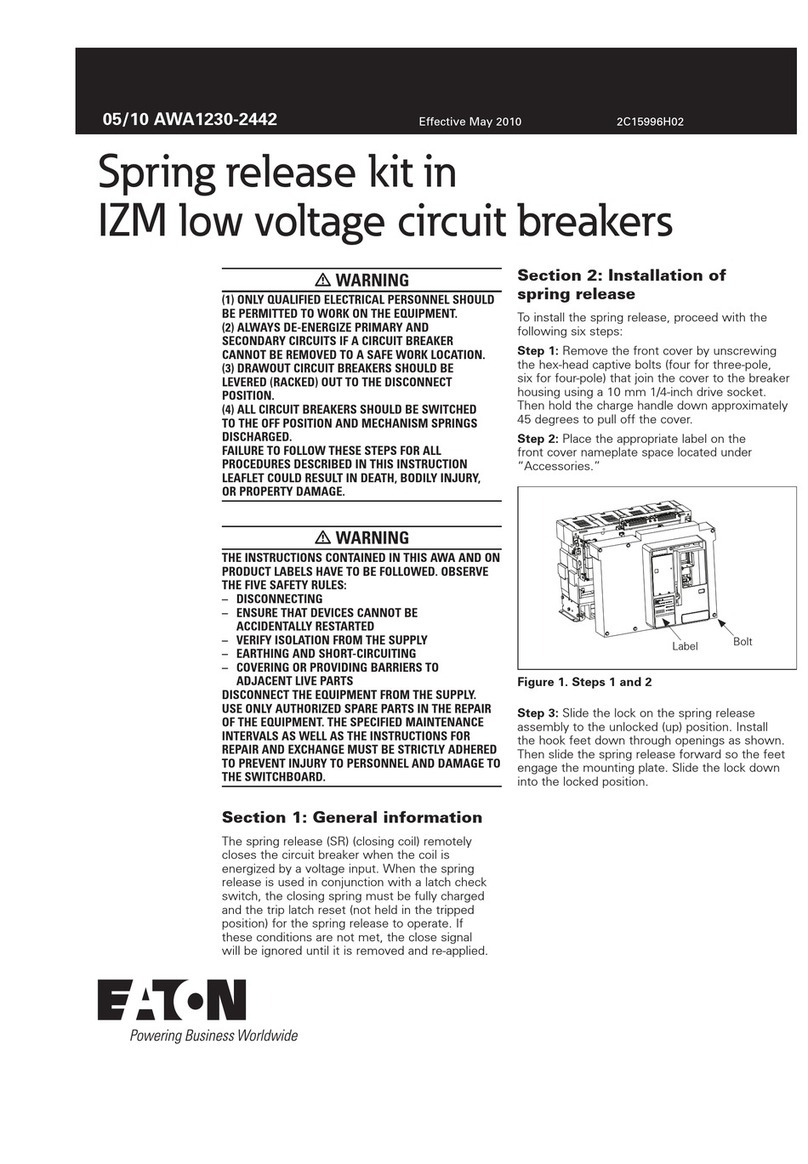
Eaton
Eaton IZM quick start guide
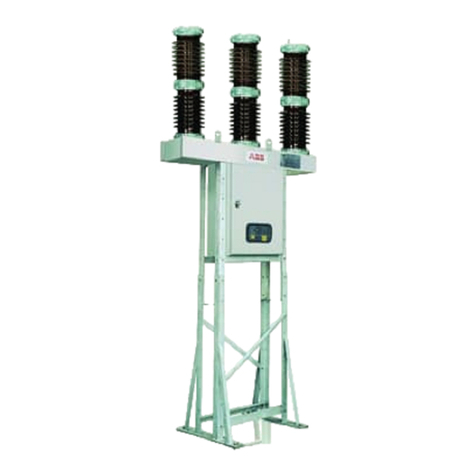
ABB
ABB VBF Series Instruction for Installation, Service and Maintenance
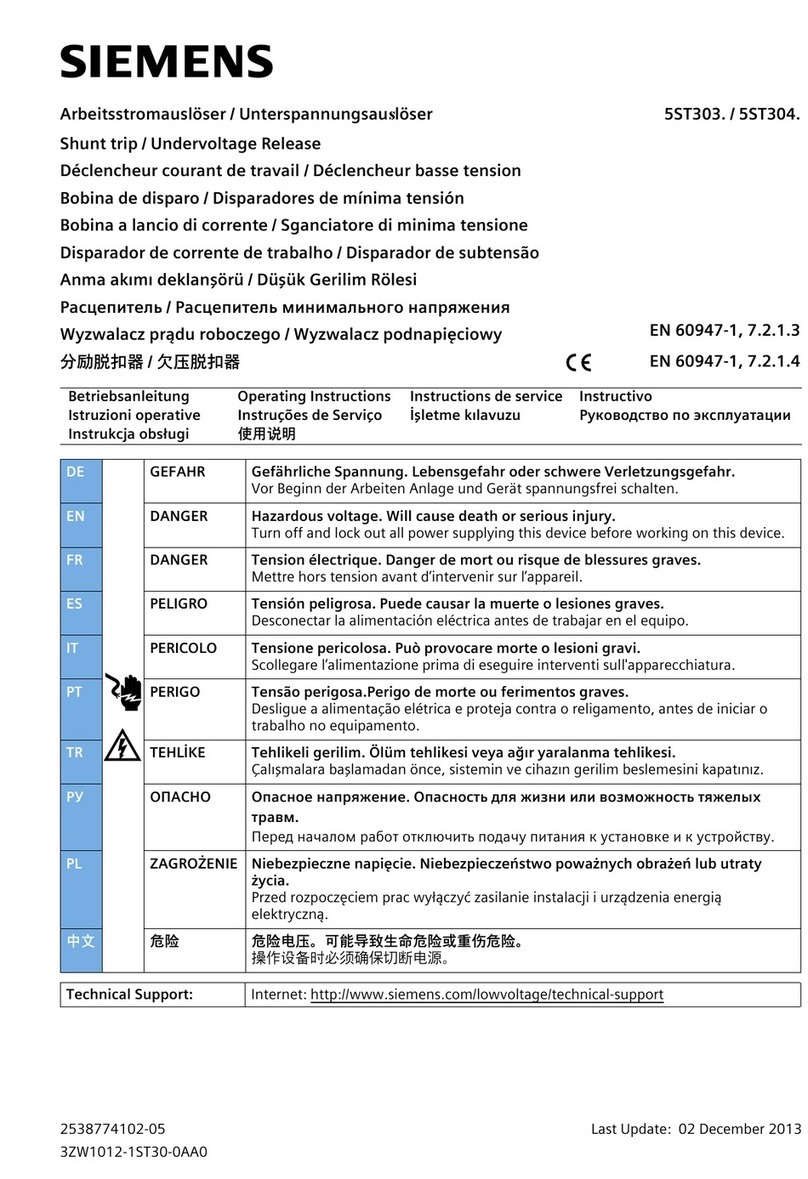
Siemens
Siemens 5ST303 Series operating instructions
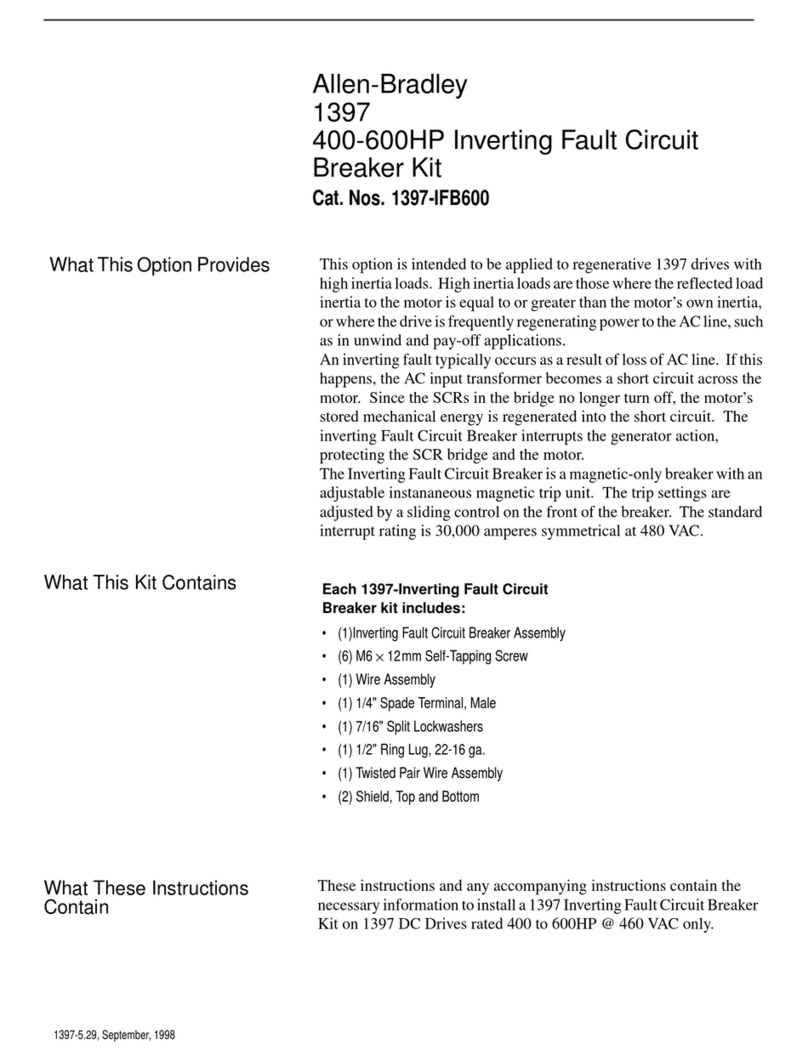
Rockwell Automation
Rockwell Automation Allen-Bradley 1397 instructions
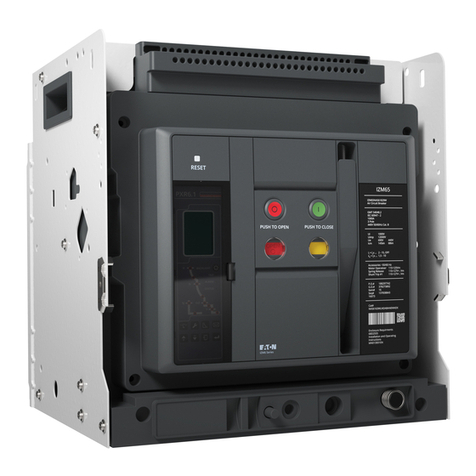
Eaton
Eaton IZM6 Series Operating instruction

Siemens
Siemens 3VT9500-8LC30 operating instructions

